Sony A1032051 GSM 850/900/1900 mobile phone with Bluetooth User Manual W380a UG AE 1206 2583 1 12
Sony Mobile Communications Inc GSM 850/900/1900 mobile phone with Bluetooth W380a UG AE 1206 2583 1 12
Sony >
08 user manual

Thank you for purchasing a Sony Ericsson W380a.
Enjoy your music wherever you go.
For additional phone content,
go to www.sonyericsson.com/fun.
Register now to get a suite of tools, free online
storage, special offers, news and competitions
at www.sonyericsson.com/myphone.
For product support, go to www.sonyericsson.com/support.
This is the Internet version of the User's guide. © Print only for private use.
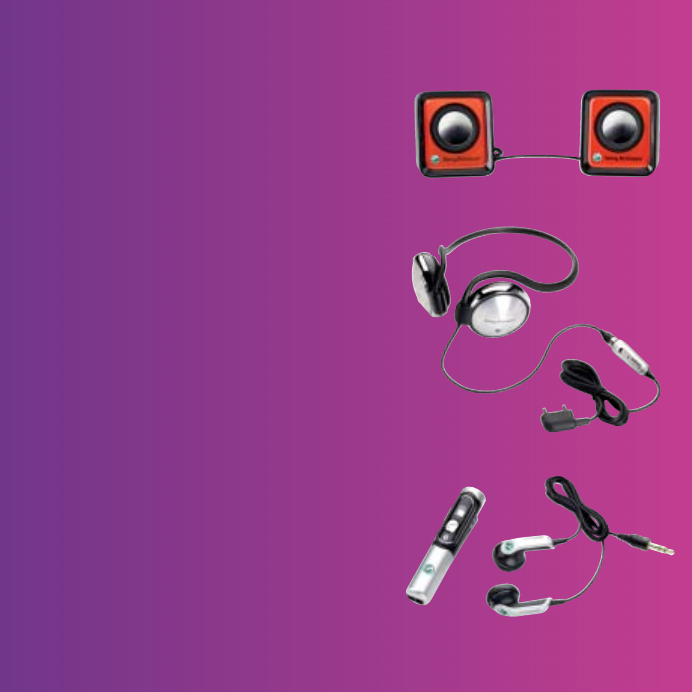
Accessories – More for your Phone
These accessories can be purchased separately
but may not be available in every market. To view the
full range go to www.sonyericsson.com/accessories.
Portable Speakers MPS-70
Small yet powerful speakers that fit
in your pocket
Stereo Portable Handsfree
HPM-83
Street-style neck band headset with
superior audio performance
Stereo Bluetooth™ Headset
HBH-DS200
Enjoy wireless music without missing
a call
This is the Internet version of the User's guide. © Print only for private use.
1Contents
Contents
Getting Started ................... 5
Assembly ........................................ 5
Turning on the Phone ..................... 6
Making and Receiving Calls ........... 7
Help in your Phone ......................... 7
Charging the Battery ....................... 8
Phone Overview .............................. 9
Menu Overview ............................. 11
Navigation ..................................... 13
Shortcuts ...................................... 15
Activity Menu ................................ 15
File Manager ................................. 15
Phone Language ........................... 18
Entering Text ................................. 18
Calling ............................... 19
Making and Receiving Calls ......... 19
Emergency Calls ........................... 19
Contacts ....................................... 20
Groups .......................................... 22
Call List ......................................... 22
Speed Dial .................................... 23
Voicemail ...................................... 23
Forwarding Calls ........................... 23
More than One Call ....................... 24
Conference Calls .......................... 25
My Numbers ................................. 25
Accept Calls .................................. 25
Restricted Dialing ......................... 26
Fixed Dialing ................................. 26
Call Time and Cost ....................... 26
Business Cards ............................. 27
Messaging ........................ 27
Text Messages ............................. 27
Picture Messages ......................... 29
Templates ..................................... 30
Voice Messages ............................ 31
Email ............................................. 31
My Friends .................................... 34
Area and Cell Information ............. 35
Imaging ............................ 36
Camera ......................................... 36
Transferring Pictures .................... 37
Pictures ......................................... 38
This is the Internet version of the User's guide. © Print only for private use.
2Contents
Entertainment ................... 39
Stereo Portable Handsfree ........... 39
Walkman® Player ......................... 39
Transferring Music from
a Computer ................................... 41
TrackID™ ...................................... 42
Radio ............................................ 42
PlayNow™ .................................... 43
Ringtones and Melodies ............... 43
MusicDJ™ .................................... 44
Sound Recorder ........................... 44
Video Player .................................. 45
Games .......................................... 45
Applications .................................. 45
Connectivity ...................... 46
Settings ......................................... 46
Using Internet ............................... 46
RSS Reader .................................. 48
Bluetooth™ Wireless
Technology ................................... 48
Using the USB Cable .................... 50
Synchronizing ............................... 52
Update Service ............................. 53
More Features .................. 54
Gesture Control ............................ 54
Alarms ........................................... 55
Calendar ....................................... 55
Tasks ............................................ 57
Notes ............................................ 57
Timer, Stopwatch and
Calculator .................................... 58
Code Memo .................................. 58
Profiles .......................................... 59
Time and Date .............................. 60
Themes ......................................... 60
Locks ............................................ 60
IMEI Number ................................. 61
Troubleshooting ............... 62
Common Questions ...................... 62
Error Messages ............................. 63
Important Information ...... 65
Guidelines for Safe and
Efficient Use .................................. 67
Limited Warranty .......................... 71
FCC Statement ............................. 73
Index ................................. 74
This is the Internet version of the User's guide. © Print only for private use.
3
Sony Ericsson W380a
GSM 850/1800/1900
This User guide is published by Sony Ericsson
Mobile Communications AB or its local affiliated
company, without any warranty. Improvements
and changes to this User guide necessitated by
typographical errors, inaccuracies of current
information, or improvements to programs and/or
equipment, may be made by Sony Ericsson Mobile
Communications AB or its local affiliated company
at any time and without notice. Such changes will,
however, be incorporated into new editions of this
User guide.
All rights reserved.
©Sony Ericsson Mobile Communications AB, 2007
Publication number: 1206-2583.1
Please note:
Some of the services in this User guide are not
supported by all networks. This also applies to the
GSM International Emergency Number 112.
Please contact your network operator or service
provider if you are in doubt whether you can use
a particular service or not.
Please read the Guidelines for safe and efficient use
and the Limited warranty chapters before you use
your phone.
Your phone has the capability to download,
store and forward additional content, for example
ringtones. The use of such content may be restricted
or prohibited by rights of third parties, including but
not limited to restriction under applicable copyright
laws. You, and not Sony Ericsson, are entirely
responsible for additional content that you download
to or forward from your phone. Prior to your use
of any additional content, please verify that your
intended use is properly licensed or is otherwise
authorized. Sony Ericsson does not guarantee
the accuracy, integrity or quality of any additional
content or any other third party content. Under no
circumstances will Sony Ericsson be liable in any
way for your improper use of additional content or
other third party content.
Bluetooth is a trademark or registered trademark
of Bluetooth SIG Inc. and any use of such mark
by Sony Ericsson is under license.
The Liquid Identity logo, PlayNow, TrackID and
MusicDJ are trademarks or registered trademarks
of Sony Ericsson Mobile Communications AB.
Sony, Memory Stick Micro, M2, WALKMAN and
the WALKMAN logo are trademarks or registered
trademarks of Sony Corporation.
Ericsson is a trademark or registered trademark of
Telefonaktiebolaget LM Ericsson.
Adobe and Photoshop are trademarks or registered
trademarks of Adobe Systems Incorporated in the
United States and/or other countries.
TrackID is powered by Gracenote Mobile MusicID™.
Gracenote and Gracenote Mobile MusicID are
trademarks or registered trademarks of Gracenote, Inc.
Microsoft, Windows, Outlook and Vista are
trademarks or registered trademarks of Microsoft
Corporation in the United States and/or other
countries.
T9™ Text Input is a trademark or a registered
trademark of Tegic Communications. T9™ Text Input
is licensed under one or more of the following: U.S.
Pat. Nos. 5,818,437, 5,953,541, 5,187,480, 5,945,928,
and 6,011,554; Canadian Pat. No. 1,331,057, United
Kingdom Pat. No. 2238414B; Hong Kong Standard
Pat. No. HK0940329; Republic of Singapore Pat. No.
51383; Euro.Pat. No. 0 842 463(96927260.8) DE/DK,
FI, FR, IT, NL, PT, ES, SE, GB; and additional patents
are pending worldwide.
Java and all Java based trademarks and logos
are trademarks or registered trademarks of Sun
Microsystems, Inc. in the U.S. and other countries.
End-user license agreement for Sun™ Java™ J2ME™.
Restrictions: Software is confidential copyrighted
information of Sun and title to all copies is retained
by Sun and/or its licensors. Customer shall not
This is the Internet version of the User's guide. © Print only for private use.

4
modify, decompile, disassemble, decrypt, extract,
or otherwise reverse engineer Software. Software
may not be leased, assigned, or sublicensed,
in whole or in part.
Export Regulations: Software, including technical
data, is subject to U.S. export control laws,
including the U.S. Export Administration Act and
its associated regulations, and may be subject to
export or import regulations in other countries.
Customer agrees to comply strictly with all such
regulations and acknowledges that it has the
responsibility to obtain licenses to export, re-
export, or import Software. Software may not be
downloaded, or otherwise exported or re-exported
(i) into, or to a national or resident of, Cuba, Iraq,
Iran, North Korea, Libya, Sudan, Syria (as such
listing may be revised from time to time) or any
country to which the U.S. has embargoed goods;
or (ii) to anyone on the U.S. Treasury Department's
list of Specially Designated Nations or the U.S.
Commerce Department's Table of Denial Orders.
Restricted Rights: Use, duplication or disclosure
by the United States government is subject to the
restrictions as set forth in the Rights in Technical
Data and Computer Software Clauses in DFARS
252.227-7013(c) (1) (ii) and FAR 52.227-19(c) (2)
as applicable.
Other product and company names mentioned
herein may be the trademarks of their respective
owners.
Any rights not expressly granted herein are reserved.
All illustrations are for illustration only and may not
accurately depict the actual phone.
Instruction Symbols
The following appear in the User guide.
Note
Tip
Warning
A service or function is network-
or subscription-dependent.
Contact your network operator
for details.
> Use a selection or navigation
key to scroll and select. See
Navigation on page 13.
Press the navigation key center.
Press the navigation key up.
Press the navigation key down.
Press the navigation key left.
Press the navigation key right.
This is the Internet version of the User's guide. © Print only for private use.
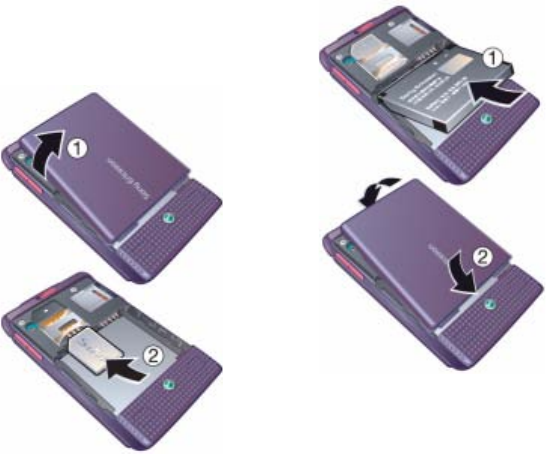
5Getting Started
Getting Started
Assembly
Before you start using your phone,
you need to insert a SIM card and
the battery.
To insert the SIM card
1Remove the battery cover.
2Slide the SIM card into its holder with
the contacts facing down.
To insert the battery
1Insert the battery with the label side up
and the connectors facing each other.
2Replace the battery cover.
This is the Internet version of the User's guide. © Print only for private use.
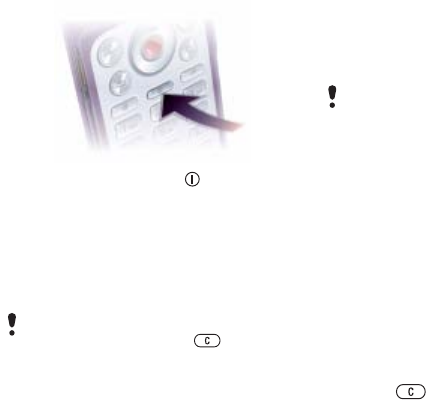
6Getting Started
Turning on the Phone
To turn on the phone
1Press and hold down .
2Select a mode:
•Normal – full functionality.
•Flight Mode – limited functionality.
3Enter your SIM card PIN, if requested.
4Select a language.
5Select Yes to use the setup wizard.
SIM card
The SIM (Subscriber Identity Module)
card, which you get from your network
operator, contains information about
your subscription. Always turn off your
phone and detach the charger before
you insert or remove the SIM card.
PIN
You may need a PIN (Personal
Identification Number) to activate the
services in your phone. Your PIN is
supplied by your network operator.
Each PIN digit appears as *, unless it
starts with emergency number digits,
for example, 112 or 911. You can
see and call an emergency number
without entering a PIN.
To delete numbers from the display
•Press .
If you make a mistake when you enter
your PIN, you can press to delete
numbers from the screen.
You can save contacts on the SIM card
before you remove it from your phone.
See To copy names and numbers to the
SIM card on page 21.
This is the Internet version of the User's guide. © Print only for private use.

7Getting Started
Flight mode
In Flight Mode the network and radio
transceivers are turned off to prevent
disturbance to sensitive equipment.
Startup screen
The startup screen appears when
you turn your phone on. See Using
pictures on page 38.
Standby
After you have turned your phone
on and entered your PIN, the name
of the network operator appears on
the screen. This is called standby.
Making and Receiving Calls
You must turn on your phone and be
within range of a network.
To make a call
1From standby enter a phone number
(with international country code and
area code, if applicable).
2Select Call.
To answer a call
•Select Answer.
To reject a call
•Select Busy.
Help in your Phone
Help and information is available in your
phone at any time. See Navigation on
page 13.
To use the setup wizard
1From standby select Menu > Settings
>the General tab > Setup Wizard.
2Select an option.
If you enter the wrong PIN three times in
a row, PIN Blocked appears. To unblock
it, you need to enter your PUK (Personal
Unblocking Key). See SIM card lock on
page 60.
You can use the Bluetooth™ function in
Flight mode.
This is the Internet version of the User's guide. © Print only for private use.
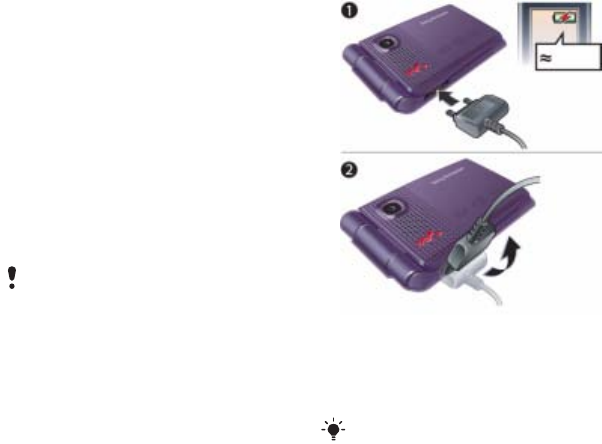
8Getting Started
To view information about functions
•Scroll to a function and select Info, if
available. In some cases, Info appears
under More.
To view the phone demonstration
•From standby select Menu
>Entertainment > Demo Tour.
Settings download
You can download settings to your
phone. These settings let you use
functionality that require Internet
accounts, for example, picture
messaging and email.
To download settings
•From standby select Menu > Settings
>the General tab > Setup Wizard
>Settings Download.
Charging the Battery
The phone battery is partly charged
when you buy it.
To charge the battery
1Connect the charger to the phone. It
takes approximately 2.5 hours to fully
charge the battery.
2Remove the charger by tilting the plug
upwards.
Contact your network operator or
service provider for more information.
You can use your phone while it is
charging. You can charge the battery
at any time and for more or less than
2.5 hours. You can interrupt the charging
without damaging the battery.
2.5 h.
This is the Internet version of the User's guide. © Print only for private use.
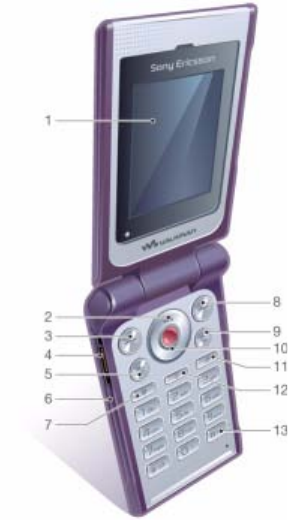
9Getting Started
Phone Overview
1Screen
2Walkman® player control
3Selection key
4Connector for charger,
handsfree and USB cable
5Back key
6
Memory card slot (under the cover)
7Internet key
8Selection key
9Clear key
10 Navigation key
11 Activity menu key
12 On/off key
13 Silent key
This is the Internet version of the User's guide. © Print only for private use.
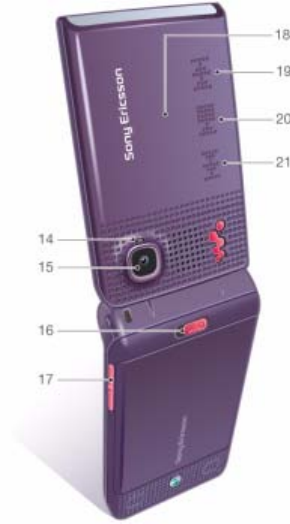
10 Getting Started
14 Gesture control light
15 Camera
16 Music key lock
17 Volume, camera digital zoom
buttons
18 External display
19 Fast forward (music key)
20 Play/Pause/Stop (music key)
21 Back (music key)
This is the Internet version of the User's guide. © Print only for private use.
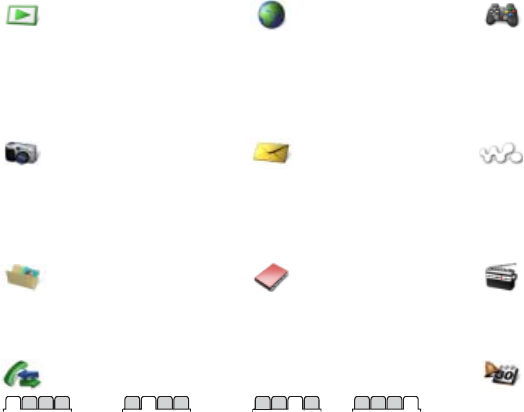
11Getting Started
Menu Overview
PlayNow™* Internet* Entertainment
Online Services*
Games
TrackID™
Video Player
MusicDJ™
Record Sound
Demo Tour
Camera Messaging WALKMAN
Write New
Inbox
Email
RSS Reader
Drafts
Outbox
Sent Messages
Saved Messages
My Friends*
Call Voicemail
Templates
Settings
File Manager** Contacts Radio
Calls** Organizer
All Answered Dialed Missed
Alarms
Applications
Calendar
Tasks
Notes
Synchronization
Timer
Stopwatch
Calculator
Code Memo
This is the Internet version of the User's guide. © Print only for private use.

12 Getting Started
Settings**
General
Profiles
Time & Date
Language
Update Service
Gesture control
New Events
Shortcuts
Flight Mode
Security
Setup Wizard
Phone Status
Master Reset
Sounds & Alerts
Ring Volume
Ringtone
Silent Mode
Increasing Ring
Vibrating Alert
Message Alert
Key Sound
Display
Wallpaper
Themes
Startup Screen
Screen Saver
Brightness
Edit Line Names*
Calls
Speed Dial
Forward Calls
Switch to Line 2*
Manage Calls
Time & Cost*
Show/Hide My No.
Handsfree
Open to Answer
Connectivity
Bluetooth
USB Connection
Synchronization
Device Mgmt.
Mobile Networks
Data Comm.
Internet Settings
Accessories
* Some menus are operator-, network- and subscription-dependent.
** You can use the navigation key to scroll between tabs in submenus. For more information,
see Navigation on page 13.
This is the Internet version of the User's guide. © Print only for private use.
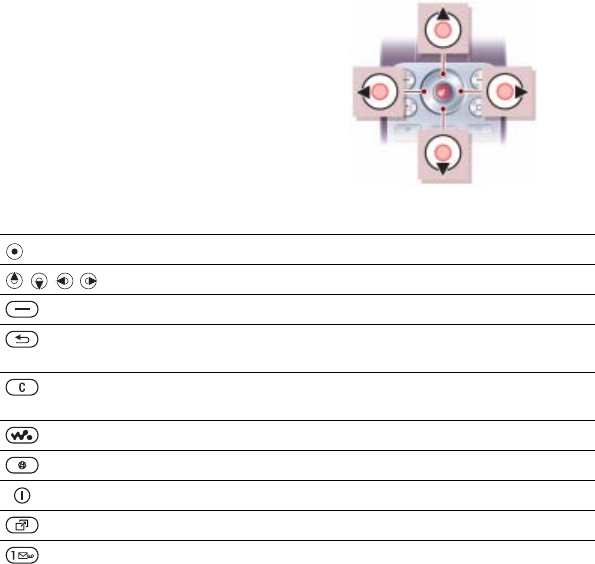
13Getting Started
Navigation
The main menus are shown as icons.
Some submenus include tabs.
To navigate the phone menus
1From standby select Menu.
2Use the navigation key to move
through the menus.
To scroll between the tabs
•Scroll to a tab by pressing the
navigation key left or right.
Key
Go to the main menus or select items
Scroll between the menus and tabs
Select options shown immediately above these keys on the screen
Go back one level in the menus.
Press and hold down to return to standby or end a function
Delete items, such as pictures, sounds and contacts.
Press and hold down to mute the microphone during a call
Open the Walkman® player
Open the browser
Turn the phone on/off
Open the activity menu
Press and hold down to call your voicemail service (if set)
This is the Internet version of the User's guide. © Print only for private use.
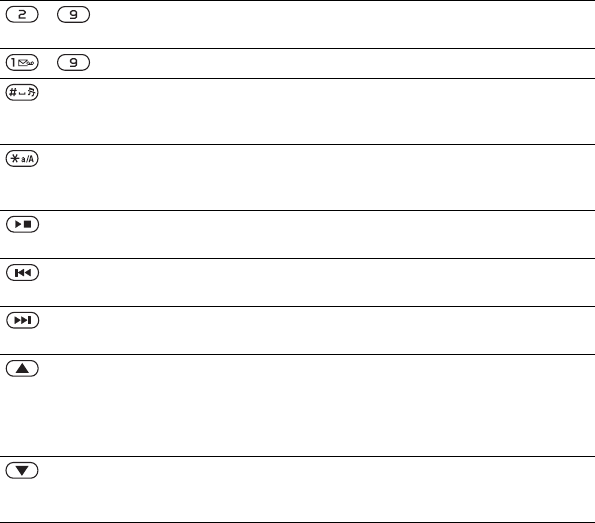
14 Getting Started
- Press and hold down a number key to reach a contact beginning
with a specific letter
- Press a number key and select Call to speed dial
Press to turn off the ringtone when you receive a call.
Press and hold down to set the phone to silent. The alarm signals
even if your phone is set to silent
Press to change letter case when writing a message.
Press and hold to toggle T9™ Text Input on and off when writing
a message
Turn the Walkman® player on or off, pause and play.
Start and stop the radio.
Skip to the previous track when using the Walkman® player.
Search for radio channels.
Skip to the next track when using the Walkman® player.
Search for radio channels.
View status information in standby.
Increase the volume during a call, or when you use the Walkman®
player.
Increase brightness when you use the camera.
Press twice to reject a call
Decrease the volume during a call, or when you use the Walkman®
player.
Decrease brightness when you use the camera
This is the Internet version of the User's guide. © Print only for private use.
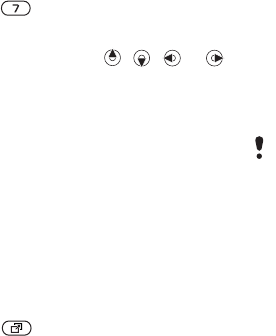
15Getting Started
Shortcuts
You can use keypad shortcuts to go
directly to a menu. Menu numbering
starts from the top left icon and moves
across and then down row by row.
To go directly to the seventh menu
•From standby select Menu and
press .
To use navigation key shortcuts
•From standby press , , or
to go directly to a function.
To edit a navigation key shortcut
1From standby select Menu > Settings
>the General tab > Shortcuts.
2Scroll to an option and select Edit.
3Scroll to a menu option and select
Shortcut.
Activity Menu
The activity menu gives you fast
access to certain functions.
To open the activity menu
•Press .
Activity menu tabs
•New Events – view missed calls and
new messages. These can also be
set to appear as pop-up texts.
•Running Apps – applications that are
running in the background.
•My Shortcuts – add your favorite
functions to access them quickly.
•Internet – your Internet bookmarks.
To select pop-up texts
•From standby select Menu > Settings
>the General tab > New Events
>Popup.
File Manager
You can use the file manager to handle
items saved in the phone memory or on
a memory card.
Memory card
Your phone supports Memory Stick
Micro™ (M2™) memory card adding
more storage space to your phone.
It can also be used as a portable
memory card with other compatible
devices.
You may have to purchase a memory
card separately.
This is the Internet version of the User's guide. © Print only for private use.
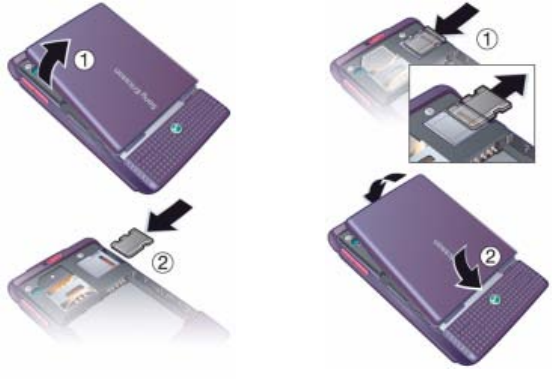
16 Getting Started
To insert a memory card
1Remove the battery cover.
2Insert the memory card with the
gold-colored contacts facing down.
To remove a memory card
1Press the edge to release and remove
the memory card.
2Replace the battery cover.
This is the Internet version of the User's guide. © Print only for private use.

17Getting Started
To view memory card options
1From standby select Menu > File
Manager >the On Memory Stick tab.
2Select More.
Handling files
You can move and copy files
between your phone, a computer
and a memory card. Files are saved
on the memory card first and then
in the phone memory. Unrecognized
files are saved in the Other folder.
You can create subfolders to move
or copy files to. When you handle files,
you can select more than one or all the
files in a folder at the same time for all
items except Games and Applications.
If the memory is full, delete some
content to create space.
File manager tabs
The file manager is divided into three
tabs, and icons indicate where the
files are saved.
•All Files – all content in the phone
memory and on a memory card.
•On Memory Stick – all content on
a memory card.
•In Phone – all content in the phone
memory.
To view information about files
1From standby select Menu > File
Manager.
2Scroll to a folder and select Open.
3Scroll to a file and select More
>Information.
To move a file in the file manager
1From standby select Menu > File
Manager.
2Scroll to a folder and select Open.
3Scroll to a file and select More
>Manage File > Move.
4Select an option.
To select more than one file in a folder
1From standby select Menu > File
Manager.
2Scroll to a folder and select Open.
3Select More > Mark > Mark Several.
4Select Mark to mark the files.
To delete a file from the file manager
1From standby select Menu > File
Manager.
2Find the file and press .
This is the Internet version of the User's guide. © Print only for private use.

18 Getting Started
Phone Language
You can select a language to use in
your phone.
To change the phone language
1From standby select Menu > Settings
>the General tab > Language > Phone
Language.
2Select an option.
Entering Text
You can use multitap text input or T9™
Text Input to enter text. The T9 Text
Input method uses a built-in dictionary.
To change text input method
•When you enter text, press and hold
down .
To shift between capitals
and lower-case letters
•When you enter text, press .
To enter numbers
•When you enter text, press and hold
down – .
To enter periods and commas
•When you enter text, press .
To enter text using T9™ Text Input
1From standby select, for example,
Menu > Messaging > Write New
>Text Message.
2If is not displayed, press and hold
down to change to T9 Text Input.
3Press each key only once, even if
the letter you want is not the first letter
on the key. For example, if you want
to write the word “Jane”, press ,
, , . Write the whole word
before looking at the suggestions.
4Use or to view suggestions.
5Press to accept a suggestion.
To enter text using multitap
1From standby select, for example,
Menu > Messaging > Write New
>Text Message.
2If is displayed, press and hold down
to change to multitap text input.
3Press – repeatedly until the
desired letter appears.
4When a word is written, press
to add a space.
To add words to the built-in
dictionary
1When you enter text using T9 Text
Input, select More > Spell Word.
2Write the word using multitap input
and select Insert.
This is the Internet version of the User's guide. © Print only for private use.
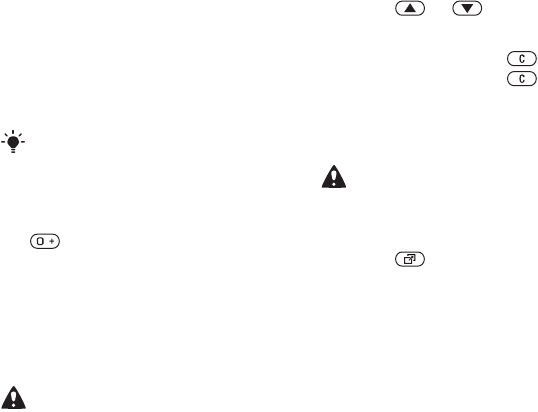
19Calling
Calling
Making and Receiving Calls
You need to turn on your phone and
be within range of a network.
To make a call
1From standby enter a phone number
(with international country code and
area code, if applicable).
2Select Call.
To make international calls
1From standby press and hold down
until a “+” sign appears.
2Enter the country code, area code
(without the first zero) and phone
number.
3Select Call.
To re-dial a number
•When Retry? appears select Yes.
To answer a call
•Select Answer.
To reject a call
•Select Busy.
To change the ear speaker volume
during a call
•Press or .
To mute the microphone during a call
1Press and hold down .
2Press and hold down again to
resume.
To turn the loudspeaker on during a call
•Select More > Turn On Speaker.
To view missed calls from standby
•Press and scroll to the New
Events tab and select a number.
•If pop-up is set: select Calls and scroll
to the Missed tab and select a number.
Emergency Calls
Your phone supports international
emergency numbers, for example,
112 and 911. These numbers can
normally be used to make emergency
calls in any country, with or without
the SIM card inserted, if a network is
within range.
You can call numbers from the contacts
and call list. See Contacts on page 20,
and Call List on page 22.
Do not hold your phone to your ear
when waiting. When the call connects,
your phone gives a loud signal.
Do not hold your phone to your ear when
using the loudspeaker. This could damage
your hearing.
This is the Internet version of the User's guide. © Print only for private use.

20 Calling
To make an emergency call
•
From standby enter 112 (the international
emergency number) and select
Call
.
To view your local emergency
numbers
1From standby select Menu > Contacts.
2Select More > Options > Special
Numbers > Emergency Nos.
Contacts
You can save names, phone numbers
and personal information in Contacts.
Information can be saved in the phone
memory or on the SIM card.
Default contact
You can choose which contact
information – Phone Contacts or
SIM Contacts – is shown as default.
If Phone Contacts is selected as
default, your contacts show all the
information saved in Contacts. If you
select SIM Contacts as default, your
contacts show names and numbers
saved on the SIM card.
To select default contacts
1From standby select Menu > Contacts.
2Scroll to New Contact and select
Options > Advanced > Default
Contacts.
3Select an option.
Phone contacts
Phone contacts can contain names,
phone numbers and personal
information. They are saved in the
phone memory.
To add a phone contact
1From standby select Menu > Contacts.
2Scroll to New Contact and select Add.
3Enter the name and select OK.
4Enter the number and select OK.
5Select a number option.
6Scroll between tabs and select the
fields to add information.
7Select Save.
To add an item to a phone contact
1From standby select Menu > Contacts.
2Scroll to a contact and select More
>Edit Contact.
3Scroll between the tabs and select
Add.
4Select an option and an item to add.
5Select Save.
In some countries, other emergency
numbers may also be promoted. Your
network operator may therefore have
saved additional local emergency
numbers on the SIM card.
This is the Internet version of the User's guide. © Print only for private use.

21Calling
To copy names and numbers to the
SIM card
1From standby select Menu > Contacts.
2Select More > Options > Advanced
>Copy to SIM.
3Select an option.
To call a phone contact
1From standby select Menu > Contacts.
2Scroll to a contact and select Call.
To call a SIM contact from phone
contacts
1From standby select Menu > Contacts
>More > Options > SIM Contacts.
2Scroll to a contact and select Call.
To automatically save names and
phone numbers on the SIM card
1From standby select Menu > Contacts.
2Select More > Options > Advanced
>Auto Save on SIM.
3Select an option.
SIM contacts
SIM contacts can contain names and
numbers only. They are saved on the
SIM card.
To add a SIM contact
1From standby select Menu > Contacts.
2Scroll to New Contact and select Add.
3Enter the name and select OK.
4Enter the number and select OK.
5Select a number option and add more
information, if available.
6Select Save.
To copy names and numbers to
phone contacts
1From standby select Menu > Contacts.
2Select More > Options > Advanced
>Copy from SIM.
3Select an option.
To call a SIM contact
1From standby select Menu > Contacts.
2Scroll to a contact and select Call.
Deleting contacts
To delete a contact
1From standby select Menu > Contacts.
2Scroll to a contact and press .
To delete all phone contacts
1From standby select Menu > Contacts.
2Select More > Options > Advanced
>Delete all contacts.
If your subscription supports Calling Line
Identification (CLI) service, you can
assign personal ringtones to contacts.
When you copy all contacts from your
phone to the SIM card, all existing
SIM card information is replaced.
To go directly to a contact, from standby
press – . See Speed Dial on
page 23.
This is the Internet version of the User's guide. © Print only for private use.

22 Calling
Sending contacts
To send a contact
1From standby select Menu > Contacts.
2Scroll to a contact and select More
>Send Contact.
3Select a transfer method.
Memory status
The number of contacts you can save in
your phone or on the SIM card depends
on available memory.
To view memory status
1From standby select Menu > Contacts.
2Select More > Options > Advanced
>Memory Status.
To save contacts on a memory card
1From standby select Menu > Contacts.
2Select More > Options > Advanced
>Back Up To M.S.
Synchronizing contacts
Contacts can be synchronized
with your computer and some Web
applications. For more information,
see Synchronizing on page 52.
Groups
You can create a group of phone
numbers and email addresses to
send messages to. See Messaging
on page 27. You can also use groups
(with phone numbers) when you
create accepted callers lists. See
Accept Calls on page 25.
To create a group of numbers and
email addresses
1From standby select Menu > Contacts
>Options > Groups > New Group.
2Enter a name for the group and select
Continue.
3Select New to find and select a contact
phone number or email address.
4Repeat step 3 to add more phone
numbers or email addresses.
5Select Done.
Call List
You can view information about most
recent calls.
To call a number from the call list
1From standby select Calls and scroll
to a tab.
2Scroll to a name or a number and
select Call.
Make sure the receiving device supports
the transfer method you select.
This is the Internet version of the User's guide. © Print only for private use.
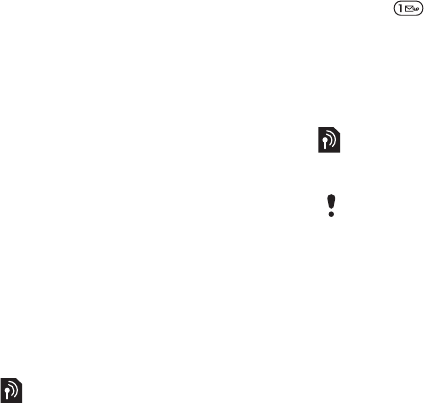
23Calling
To add a call list number to contacts
1From standby select Calls and scroll
to a tab.
2Scroll to the number and select More
>Save Number.
3Select New Contact to create a new
contact or select an existing contact
to add the number to.
To clear the call list
•From standby select Calls >the All
tab > More > Delete All.
Speed Dial
Speed dialing lets you select nine
contacts that you can dial quickly. The
contacts can be saved in positions 1-9.
To add contacts to speed dial numbers
1From standby select Menu > Contacts.
2Select Options > Speed Dial.
3Scroll to a position number and select
Add.
4Select a contact.
To speed dial
•From standby enter the position number
and select Call.
Voicemail
If your subscription includes an
answering service, callers can leave a
voicemail message when you cannot
answer a call.
To enter your voicemail number
1From standby select Menu > Messaging
>Settings > Voicemail Number.
2Enter the number and select OK.
To call your voicemail service
•From standby press and hold
down .
To edit your voicemail number
1From standby select Menu > Messaging
>Settings > Voicemail Number.
2Edit the number and select OK.
Forwarding Calls
You can forward calls, for example,
to an answering service.
Forward call options
Standard options are:
•Always Forward – forward all your
calls
•When Busy – if a call is ongoing
•Not Reachable – if turned off or
unreachable
•No Reply – if not answered in
a specified time
When Restrict Calls is used, some
forward call options are not available.
See Restricted Dialing on page 26.
This is the Internet version of the User's guide. © Print only for private use.

24 Calling
To forward calls
1From standby select Menu > Settings
>the Calls tab > Forward Calls.
2Scroll to a call type and forward option
and select Activate.
3Enter the number to forward calls to
and select OK.
More than One Call
You can handle more than one call at
the same time. For example, you can
put an ongoing call on hold, while you
make or answer a second call. You
can also switch between the two calls.
You cannot answer a third call without
ending one of the first two calls.
Call waiting
When call waiting is used, you hear
a beep if you receive a second call.
To activate call waiting
•From standby select Menu > Settings
>the Calls tab > Manage Calls > Call
Waiting > Activate.
To make a second call
1During the call, select More > Hold.
This puts the ongoing call on hold.
2Enter the number to call and select
More > Call.
To answer a second call
•During the call, select Answer. This puts
the ongoing call on hold.
To reject a second call
•
During the call, select
Busy
and continue
with the ongoing call.
To end an ongoing call and answer
a second call
•During the call, select Replace Actve
Call.
Handling two voice calls
You can have calls ongoing and on
hold at the same time.
To switch between two calls
•During the call, select More > Switch.
To join two calls
•During the call, select More > Join Calls.
To connect two calls
•During the call, select More > Transfer
Call. You are disconnected from both
calls (operator-dependent).
To end an ongoing call and return
to the call on hold
•Select End Call > Yes.
To end both calls
•Select End Call > No.
This is the Internet version of the User's guide. © Print only for private use.

25Calling
Receiving a third voice call
You cannot answer a third call without
ending one of the first two calls or
joining them into a conference call.
Conference Calls
With a conference call, you can have a
joint conversation with up to five people.
To join the two calls
•
During the call, select
More
>
Join Calls
.
To add a new participant
1During the call, select More > Hold.
This puts the joined calls on hold.
2Select More > Add Call.
3Enter the number to call and select Call.
4Select More > Join Calls to add the
new participant.
5Repeat this task to add more
participants.
To release a participant
1Select More > Release Party.
2Select the participant to release.
To have a private conversation
1During the call, select More > Talk to
and select the participant to talk to.
2To resume the conference call, select
More > Join Calls.
My Numbers
You can view, add and edit your own
phone numbers.
To check your phone numbers
1From standby select Menu > Contacts
>Options > Special Numbers
>My Numbers.
2Select an option.
Accept Calls
You can choose to receive calls from
certain phone numbers only.
To add numbers to the accepted
callers list
1From standby select Menu > Settings
>the Calls tab > Manage Calls > Accept
Calls > Only from List > New.
2Scroll to a contact or select Groups.
See Groups on page 22.
To accept all calls
•From standby select Menu > Settings
>the Calls tab > Manage Calls > Accept
Calls > All Callers.
If your subscription supports Alternate
Line Service (ALS), you can make separate
calls with different phone numbers.
This is the Internet version of the User's guide. © Print only for private use.

26 Calling
Restricted Dialing
You can restrict outgoing and
incoming calls. A password from
your service provider is required.
Restrict calls options
Standard options are:
•All Outgoing – all outgoing calls
•Outgoing Intl. – all outgoing
international calls
•Outg Intl Roam – all outgoing
international calls except to your
home country
•All Incoming – all incoming calls
•Inc. Whn Roaming – all incoming
calls when you are abroad
To restrict calls
1From standby select Menu > Settings
>the Calls tab > Manage Calls
>Restrict Calls.
2Select an option.
3Enter your password and select OK.
Fixed Dialing
Fixed dialing allows calls to be made
only to certain numbers saved on
the SIM card. The fixed numbers
are protected by your PIN2.
Partial numbers can be saved. For
example, saving 0123456 allows calls
to be made to all numbers starting
with 0123456.
To use fixed dialing
1From standby select Menu > Contacts.
2Select More > Options > Special
Numbers > Fixed Dialing > Activate.
3Enter your PIN2 and select OK.
4Select OK again to confirm.
To save a fixed number
1From standby select Menu > Contacts.
2Select More > Options > Special
Numbers > Fixed Dialing > Fixed
Numbers > New Number.
3Enter the information and select Save.
Call Time and Cost
During a call, the duration of the call
is shown. You can check the duration
of your last call, outgoing calls and the
total time of your calls.
If you forward incoming calls, you cannot
use some restrict calls options.
When fixed dialing is used, you can still call
the international emergency number, 112.
When fixed dialing is used, you cannot
view or manage any phone numbers
saved on the SIM card.
This is the Internet version of the User's guide. © Print only for private use.

27Messaging
To check the call time
•From standby select Menu > Settings
>the Calls tab > Time & Cost > Call
Timers.
Business Cards
To add your own business card
1From standby select Menu > Contacts.
2Select More > Options >My Business
Card.
3Scroll between tabs and select the
fields to add information. To enter
a symbol select More > Add Symbol
>Insert.
4Enter the information and select Save.
To send your business card
1From standby select Menu > Contacts.
2Select More > Options >My Business
Card >Send My Card.
3Select a transfer method.
Messaging
Text Messages
Text messages can contain simple
pictures, sound effects, animations,
and melodies.
Before you use messaging
You must have a service center
number. The number is supplied by
your service provider and is usually
saved on the SIM card. If the number
to your service center is not saved
on your SIM card, you must enter the
number yourself.
To enter a service center number
1From standby select Menu > Messaging
>Settings > Text Message > Service
Center. The number is shown if it is
saved on the SIM card.
2If there is no number shown, select
Edit > New ServiceCenter and enter
the number, including the international
“+” sign and country code.
3Select Save.
Sending messages
For information about entering letters,
see Entering Text on page 18.
Make sure the receiving device supports
the transfer method you select.
This is the Internet version of the User's guide. © Print only for private use.

28 Messaging
To write and send a text message
1From standby select Menu > Messaging
>Write New > Text Message.
2Write the message and select Continue
>Contacts Lookup.
3Select a recipient and select Send.
To select more than one text message
1From standby select Menu > Messaging
and select a folder.
2Scroll to a message and select More
>Mark Several.
3Select Mark to mark the messages.
To add an item to a text message
1When you write the message, select
More > Add Item.
2Select an option and then an item.
Receiving text messages
You are notified when you receive
a message. Received messages
are saved in the inbox.
To view a text message from standby
•If the activity menu is set: select View.
•If pop-up is set: follow the instructions
on the screen.
To view a text message from the inbox
1From standby select Menu > Messaging
>Inbox.
2Scroll to the message and select View.
To close a text message
•Press .
To call a number in a text message
•When you view the message, scroll to
the phone number and select Call.
Saving and deleting text messages
Received text messages are saved in
the phone memory. When the phone
memory is full, you can delete messages
or move them to the SIM card.
To save a text message on the SIM card
1From standby select Menu
>Messaging and select a folder.
2Scroll to the message and select More
>Save Message > Saved Messages.
To save an item in a text message
1When you view the message, select
the item.
2Select More > Use.
3Select an option.
To delete a text message
1From standby select Menu
>Messaging and select a folder.
2Scroll to the message and press .
If you send a text message to a group,
you will be charged for each member.
See Groups on page 22.
This is the Internet version of the User's guide. © Print only for private use.

29Messaging
Picture Messages
Picture messages can contain text,
pictures, slides, sound recordings,
signatures and attachments. You can
send picture messages to a phone or
an email address.
Before you use picture messaging
You must set an Internet profile
and the address of your message
server. If no Internet profile or
message server exists, you can
receive all the settings automatically
from your network operator or at
www.sonyericsson.com/support.
To select an Internet profile
1From standby select Menu > Messaging
>Settings > Picture Message > MMS
Profile.
2Select a profile.
To set the message server address
1From standby select Menu > Messaging
>Settings > Picture Message > MMS
Profile.
2Scroll to a profile and select More > Edit
>Message Server.
3Select Edit and enter the address.
Sending messages
For information about entering letters,
see Entering Text on page 18.
To create and send a picture message
1From standby select Menu > Messaging
>Write New > Picture Message.
2Enter the text and press to add
items to the message.
3Select Continue > Contacts Lookup.
4Select a recipient and select Send.
Receiving picture messages
You can select how to download
your picture messages. Standard
options when you download picture
messages are:
•Always – automatic download.
•Ask in Roaming – ask to download
when not in home network.
•Not in Roaming – do not download
when not in home network.
•Always Ask – ask to download.
•Off – new messages appear in the
Inbox.
To set automatic download
1From standby select Menu > Messaging
>Settings > Picture Message > Auto
Download.
2Select an option.
To view a picture message from
standby
•If the activity menu is set: select View.
•If pop-up is set: follow the instructions
on the screen.
This is the Internet version of the User's guide. © Print only for private use.

30 Messaging
To view a picture message from
the inbox
1From standby select Menu > Messaging
>Inbox.
2Scroll to the message and select View.
To close a picture message
•Press .
To save an item in a picture message
•When you view a picture message
select More > Save Items and select
an item.
To delete a message
1From standby select Menu > Messaging
and select a folder.
2Scroll to the message and press .
Message options
You can set standard options for all
messages or choose specific settings
each time you send a message.
To set text message options
1From standby select Menu > Messaging
>Settings > Text Message.
2Scroll to an option and select Edit.
To set picture message options
1From standby select Menu > Messaging
>Settings > Picture Message.
2Scroll to an option and select Edit.
Send options
You can request a delivery report,
a read report, and set a priority for
a specific message. You can also
add more recipients to the message.
To set send options
1When the message is ready and
a recipient is selected, select More
>Advanced.
2Scroll to an option and select Edit.
Templates
If you often use the same phrases and
pictures in a message, you can save
the message as a template.
To use a text message template
1From standby select Menu > Messaging
>Templates.
2Scroll to a template and select Use
>Text Message.
3Add text and select Continue and
select a recipient.
To use a picture message template
1From standby select Menu > Messaging
>Templates.
2Scroll to a template and select Use.
3When the message is ready, select
Continue and select a recipient.
This is the Internet version of the User's guide. © Print only for private use.
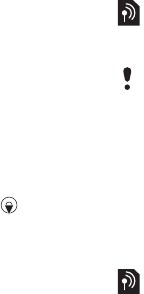
31Messaging
To add a text message template
1From standby select Menu > Messaging
>Templates > New Template > Text.
2Insert text or select More to add items.
Select OK.
3Enter a title and select OK.
To add a picture message template
1From standby select Menu
>Messaging > Templates
>New Template > Picture Msg.
2Enter the text and press to add
items to the message.
3Select Save, enter a title and select OK.
To edit a template
1From standby select Menu > Messaging
>Templates.
2Scroll to a template and select More
>Edit Template > Save.
To save a message as a template
1From standby select Menu > Messaging
>Inbox.
2Scroll to the message and select More
>Save Message > Templates.
Voice Messages
You can send and receive a sound
recording as a voice message.
To record and send a voice message
1From standby select Menu > Messaging
>Write New > Voice Message.
2Record the message and select Stop
>Send > Contacts Lookup.
3Select a recipient and select Send.
Email
You can use standard email functions
and your computer email address in
your phone.
Before you use email
Email settings must be entered in your
phone. You can have these settings
sent directly to your phone from the
Sony Ericsson support site, or you
can enter them manually.
Email settings using Internet
You can receive settings at
www.sonyericsson.com/support.
The sender and recipient must have
a subscription supporting picture
messaging.
This is the Internet version of the User's guide. © Print only for private use.
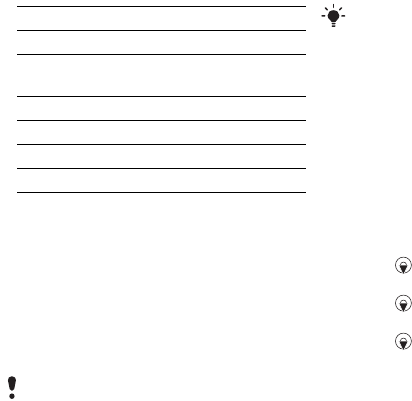
32 Messaging
Entering email settings manually
You can also enter the email settings
manually. To do this, you need to ask
your email provider for the settings
information:
An email provider could be the company
that supplied your email address, for
example, your IT administrator at work
or an Internet provider.
You may find settings information
in your computer email program
settings, or in a document from your
email provider.
To enter email settings
1From standby select Menu > Messaging
>Email > Settings.
2Enter the settings.
Help appears as you enter settings.
To write and send an email message
1From standby select Menu > Messaging
>Email > Write New.
2Select Add > Enter Email Addr. Enter
the email address and select OK.
3To enter more recipients, select Edit.
Scroll to an option and select Add
>Enter Email Addr. Enter the email
address and select OK. When you
are ready, select Done.
4Press to scroll to Subject:. Select
Edit and enter a subject.
5Press to scroll to Text:. Select Edit
and enter the text.
6Press to scroll to Attachments:.
Select Add and select a file to attach.
7Select Continue > Send.
To receive and read an email message
1From standby select Menu > Messaging
>Email > Inbox > Snd&Rec.
2Scroll to the message and select View.
Settings types Examples
Connection Type POP3 or IMAP4
Email Address joe.smith@
example.com
Incoming Server mail.example.com
Username jsmith
Password zX123
Outgoing Server mail.example.com
There are many different email providers.
Their terminology and required information
may differ. Not all service providers allow
email access.
For more information, contact
your email provider or go to
www.sonyericsson.com/support.
This is the Internet version of the User's guide. © Print only for private use.

33Messaging
To save an email message
1From standby select Menu > Messaging
>Email > Inbox.
2Scroll to the message and select More
>Save Message > Saved Email.
To reply to an email message
1From standby select Menu > Messaging
>Email > Inbox.
2Scroll to the message and select More
>Reply.
3Write the reply and select OK.
4Select Continue > Send.
To view an attachment in an email
message
•When you view the message, select
More > Attachments > View.
To save an attachment in an email
message
•When you view the message, select
More > Attachments > View > Save.
Active email account
If you have several email accounts,
you can change which one is active.
To change the active email account
1From standby select Menu > Messaging
>Email > Settings.
2Select an account.
To delete an email message (POP3)
1From standby select Menu > Messaging
>Email > Inbox.
2Scroll to the message and select More
>Mrk for Deletion > Yes.
To delete an email message (IMAP4)
1From standby select Menu > Messaging
>Email > Inbox.
2Scroll to the message and select More
>Mrk for Deletion > Yes.
3Select More > Clear Inbox.
Push email
You can receive notification in your
phone from your email server that
you have new email.
To turn on push email notification
1From standby select Menu > Messaging
>Email > Settings.
2Scroll to an account to edit and select
More > Edit Account > Advanced
Settings > Push Email.
3Select an option.
Marked messages will be deleted when
you next connect to your server.
Marked messages will be deleted in the
phone and on the server.
This is the Internet version of the User's guide. © Print only for private use.
34 Messaging
My Friends
You can connect and log in to the My
friends server to communicate online
with chat messages.
Before you use My friends
If no settings exist in your phone,
you need to enter server settings.
Standard settings information
supplied by your service provider is:
•username
•password
•server address
•Internet profile
To enter My friends server settings
1From standby select Menu > Messaging
>My Friends > Configure.
2Select Add and enter the settings.
To edit My friends settings
1From standby select Menu > Messaging
>My Friends.
2Select More > Settings.
3Scroll to the setting and select Edit.
To log in to the My friends server
•From standby select Menu > Messaging
>My Friends > Log In.
To log out of the My friends server
•Select More > Log Out.
To add a chat contact
1From standby select Menu > Messaging
>My Friends >the Contacts tab.
2Select More > Add Contact.
To send a chat message
1From standby select Menu > Messaging
>My Friends >the Contacts tab.
2Scroll to a contact and select Chat.
3Write the message and select Send.
Status
You can show your status, for example,
Happy or Busy, to your contacts only.
You can also show your status to all
users on the My friends server.
To show my status
1From standby select Menu > Messaging
>My Friends > More > Settings > Show
My Status.
2Select an option.
To update your own status
1From standby select Menu > Messaging
>My Friends >the My Status tab.
2Scroll between tabs and select the
fields to add information.
This is the Internet version of the User's guide. © Print only for private use.

35Messaging
Chat group
A chat group can be started by your
service provider, by an individual My
friends user or by yourself. You can
save chat groups by saving a chat
invitation or by searching for a specific
chat group.
To create a chat group
1From standby select Menu > Messaging
>My Friends >the Chat Groups tab.
2Select More > Add Chat Group > New
Chat Group.
3Select who to invite from your contacts
list and select Continue.
4Enter a short invitation text and select
Continue > Send.
To add a chat group
1From standby select Menu > Messaging
>My Friends >the Chat Groups tab
>More > Add Chat Group.
2Select an option.
To save a conversation
1From standby select Menu > Messaging
>My Friends >the Conversations tab.
2Enter a conversation.
3Select More > Advanced > Save Conv.
To view a saved conversation
1From standby select Menu > Messaging
>My Friends >the Conversations tab.
2Select More > Saved Conv.
Area and Cell Information
Area and cell information are text
messages, for example, local traffic
reports that are sent to subscribers
within a certain network area.
To turn area information on
1From standby select Menu > Messaging
>Settings > Area Info.
2
Scroll to
Reception
and select
Edit
>
On
.
Conversation history is saved between
log out and when you log in again to
let you return to chat messages from
previous conversations.
Contact your service provider for more
information.
This is the Internet version of the User's guide. © Print only for private use.
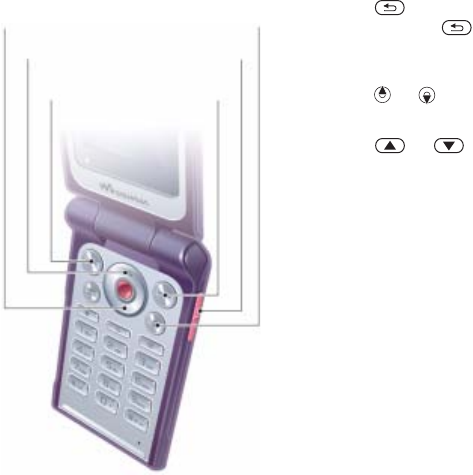
36 Imaging
Imaging
Camera
You can take pictures to view, save
or send.
To activate the camera
•From standby select Menu > Camera.
To take a picture
1Activate the camera.
2Select Capture to take a picture.
3Press to take another picture.
4Press and hold to stop the
camera.
To use zoom
•Press or .
To adjust brightness
•Press or .
Saving and deleting pictures
All camera pictures are saved in the
camera album.
To view pictures
1From standby select Menu > File
Manager > Camera Album.
2Scroll to an item and select View.
To search camera pictures by
time line
1From standby select Menu > File
Manager > Camera Album.
2To browse camera pictures sorted
by date, select More > Timeline View.
Zoom out Delete
Screen options
Take
pictures
Adjust
brightness
Zoom in
This is the Internet version of the User's guide. © Print only for private use.
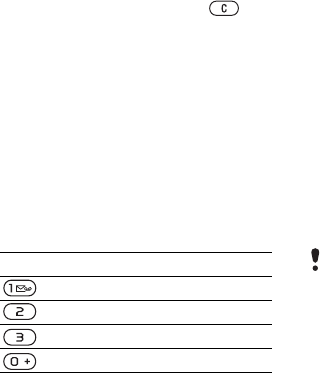
37Imaging
To delete pictures
1From standby select Menu > File
Manager > Camera Album.
2Scroll to an item and press .
Camera settings
You can select different settings
before you take a picture.
To view settings
•When the camera is activated, select
More.
To view information about settings
•Scroll to a setting and select Info.
Camera shortcuts
Transferring Pictures
Transfer to and from your computer
You can use Bluetooth technology and
picture messages to transfer pictures
to your computer. You can also use
the USB cable to drag and drop camera
pictures. See Bluetooth™ Wireless
Technology and Using the USB Cable
on page 50.
You can view, enhance and organize
your pictures on your computer by
installing Adobe™ Photoshop™ Album
Starter Edition or the Sony Ericsson
Media Manager. These are included
on the CD that comes with your phone
and are available for download at
www.sonyericsson.com/support.
Picture blog
A picture blog is a personal Web page.
If your subscription supports this
service, you can send pictures to a blog.
To send camera pictures to a blog
1From standby select Menu > File
Manager > Camera Album.
2Scroll to a picture and select More
>Send > To Blog.
3Add title and text.
4Select OK > Publish.
Key Shortcut
Shoot Mode
Picture Size
Night Mode
Key guide
Web services may require a separate
license agreement between you and the
service provider. Additional regulations
and/or charges may apply. Contact your
service provider.
This is the Internet version of the User's guide. © Print only for private use.

38 Imaging
To go to a blog address from contacts
1From standby select Menu > Contacts.
2Scroll to a contact.
3Scroll to a Web address and select
Go To.
Pictures
You can view, add, edit or delete
pictures in File Manager. File types
supported are, for example, GIF,
JPEG, BMP and PNG.
Using pictures
You can add a picture to a contact,
use it during phone startup, as a
wallpaper in standby or as a screen
saver.
To view pictures
1From standby select Menu > File
Manager > Pictures.
2Scroll to a picture and select View.
To use pictures
1From standby select Menu > File
Manager > Pictures.
2Scroll to a picture and select More
>Use As.
3Select an option.
To view pictures in a slide show
1From standby select Menu > File
Manager > Pictures.
2Scroll to a picture and select View
>More > Slide Show.
Sending and receiving
You can send and receive pictures as
a picture message, an email or using
Bluetooth.
To send a picture
1From standby select Menu > File
Manager > Pictures.
2Scroll to a picture and select More
>Send.
3Select a transfer method.
To receive a picture
•Follow the instructions that appear.
Make sure the receiving device supports
the transfer method you select.
This is the Internet version of the User's guide. © Print only for private use.
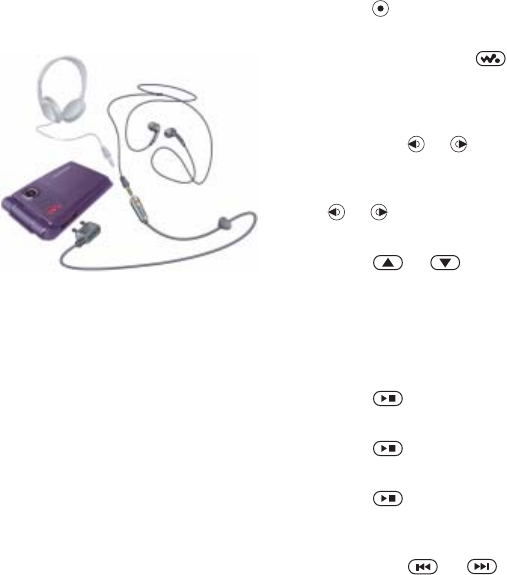
39Entertainment
Entertainment
Stereo Portable Handsfree
To use the handsfree
•Connect the portable handsfree.
Music stops when you receive a call
and resumes when the call has ended.
Walkman® Player
To play music
1From standby select Menu
>WALKMAN.
2Scroll to a title and select Play.
Walkman® player controls
The following keys are used to control
the Walkman® player with the phone
open.
To stop playing music
•Press .
To resume playing music
•From standby press and select
Play.
To fast forward and rewind
•When you listen to music, press and
hold down or .
To move between tracks
•When you listen to music, press
or .
To change the volume
•Press or .
Music key controls
The music keys are used to control
the Walkman® player with the phone
closed.
To start playing music
•Press .
To stop playing music
•Press .
To resume playing music
•Press .
To fast forward and rewind
•When you listen to music, press and
hold down or .
This is the Internet version of the User's guide. © Print only for private use.

40 Entertainment
To move between tracks
•When you listen to music, press
or .
Browsing files
Music files are saved and categorized.
•Artists – list tracks you have transferred
using Media Manager.
•Albums – list tracks by album.
•Tracks – list all music tracks in your
phone and on a memory card.
•Playlists – your own lists of tracks.
Playlists
You can create playlists to organize
files in File Manager. You can sort
the files by artist or title. Files can be
added to more than one playlist.
Deleting a playlist, or a file from a playlist,
does not delete the file from the memory,
just the reference to the file.
To create a playlist
1
From standby select
Menu
>
WALKMAN
>
More
>
My Music
.
2Scroll to Playlists and select Open.
3Scroll to New Playlist and select Add.
4Enter a name and select OK.
5Scroll to a track and select Mark.
6Select Add to add the track to the
playlist.
To add files to a playlist
1
From standby select
Menu
>
WALKMAN
>
More
>
My Music
.
2Scroll to Playlists and select Open.
3Scroll to the playlist and select Open.
4Select More > Add Media.
5Scroll to a track and select Mark.
6Select Add to add the track to the
playlist.
To remove tracks from a playlist
1
From standby select
Menu
>
WALKMAN
>
More
>
My Music
.
2Scroll to a playlist and select Open.
3Scroll to the track and press .
To delete a playlist
1
From standby select
Menu
>
WALKMAN
>
More
>
My Music
>
Playlists
.
2Scroll to a playlist and press .
To view information about a track
•Scroll to a track and select More
>Information.
Sending and receiving music
You can send and receive music in
a picture message, an email or using
Bluetooth.
You can lock the music keys with the
music key lock. See Music key lock
on page 61.
This is the Internet version of the User's guide. © Print only for private use.

41Entertainment
To send music
1From standby select Menu
>WALKMAN.
2Scroll to a title and select More > File
>Send.
3Select a transfer method.
To receive music
•Follow the instructions that appear.
Transferring Music from
a Computer
With Sony Ericsson Media Manager,
included on the CD with your phone,
you can transfer music from CDs, your
computer or that you have purchased to
the phone memory or a memory card.
Before you use Media Manager
You need one of these operating
systems to use Media Manager
on your computer:
•
Microsoft® Windows Vista™ (32 bit
and 64 bit versions of: Ultimate,
Enterprise, Business, Home Premium,
Home Basic)
•
Microsoft Windows® XP (Pro or Home)
To install Media Manager
1Turn on your computer and insert the
CD. The CD starts automatically and
the installation window opens.
2Select a language and click OK.
3Click Install Sony Ericsson Media
Manager and follow the instructions.
To use Media Manager
1
Connect the phone to a computer with
the USB cable that came with the phone.
2Select File Transfer. The phone turns
off and prepares to transfer files.
3Computer: Start/Programs/
Sony Ericsson/Media Manager.
4For safe disconnection of the USB
cable in file transfer mode, right-click
the removable disk icon in Windows
Explorer and select Eject.
See Using the USB Cable on page 50.
For details on transferring music, see
Media Manager Help. Click in the
top-right corner of the Media Manager
window.
Make sure the receiving device supports
the transfer method you select.
Sony Ericsson Media Manager
software is also available for download
at www.sonyericsson.com/support.
Do not remove the USB cable from
your phone or computer during transfer,
as this may corrupt the memory card or
the phone memory.
This is the Internet version of the User's guide. © Print only for private use.
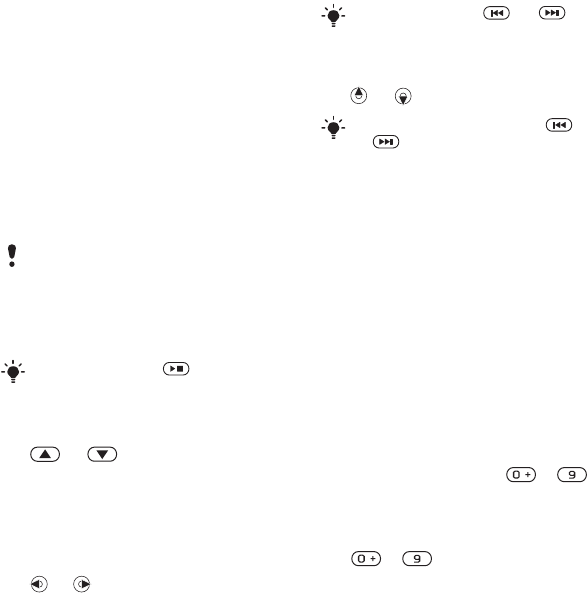
42 Entertainment
TrackID™
TrackID™ is a free music recognition
service. Search for song titles, artists
and album names.
To search for song information
•When you hear a song through
a loudspeaker, from standby select
Menu > Entertainment > TrackID™.
•When the radio is playing select More
>TrackID™.
Radio
To listen to the radio
1Connect the handsfree to the phone.
2From standby select Menu > Radio.
To change the volume
•When the radio is playing, press
or .
To automatically search for radio
channels
•
When the radio is playing, select
Search
.
To manually search for radio channels
•When the radio is playing, press
or .
To search for preset channels
•When the radio is playing, press
or .
Saving radio channels
You can save up to 20 preset channels.
To save radio channels
1From standby select Menu > Radio.
2Select Search to find a radio channel.
3Select More > Save.
4Scroll to a position and select Insert.
To select saved radio channels
1From standby select Menu > Radio
>More > Channels.
2Select a radio channel.
To save radio channels in
positions 1 to 10
•When you have found a radio channel,
press and hold down - .
To select radio channels saved
in positions 1 to 10
•When the radio is playing, press
- .
Do not use your phone as a radio
in places where this is prohibited.
You can also press to start and
stop the radio.
You can also press or
to search for radio channels.
You can also press and hold
or to search for preset channels.
This is the Internet version of the User's guide. © Print only for private use.

43Entertainment
To view radio options
•When the radio is playing, select More.
PlayNow™
You can listen to music before you
purchase and download it to your
phone.
Before you use PlayNow™
You must have the required settings in
your phone. See Settings on page 46.
To listen to PlayNow™ music
1From standby select Menu
>PlayNow™.
2Select music from a list.
Downloading from PlayNow™
The price appears when you select to
download and save a music file. Your
phone bill or prepay card is debited
when a purchase is accepted.
To download a music file
1When you have listened to a music file
preview, you can agree to accept the
conditions.
2Select Yes to download.
3A text message is sent to confirm
payment and the file is made available
to download.
Ringtones and Melodies
To set a ringtone
1From standby select Menu > Settings
>the Sounds & Alerts tab > Ringtone.
2Select an option.
To set the ringtone volume
1From standby select Menu > Settings
>the Sounds & Alerts tab > Ring
Volume.
2Press or to change the volume.
3Select Save.
To turn the ringtone off
•From standby press and hold
down .
All signals except the alarm signal are
affected.
To set the vibrating alert
1From standby select Menu > Settings
>the Sounds & Alerts tab > Vibrating
Alert.
2Select an option.
This service is not available in all
countries. Contact your network
operator for more information. In some
countries you can purchase music from
some of the world’s top musical artists.
This is the Internet version of the User's guide. © Print only for private use.
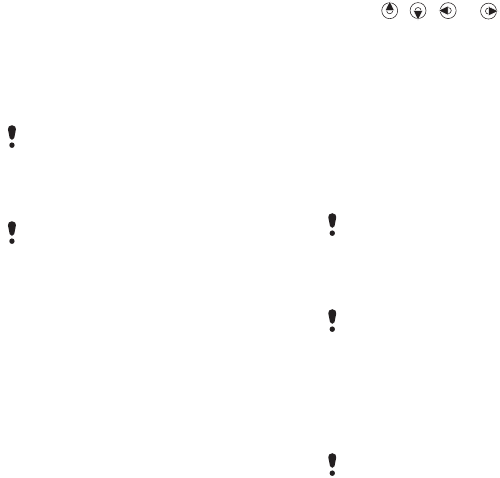
44 Entertainment
To send a ringtone
1From standby select Menu > File
Manager > Music > Ringtones.
2Scroll to a ringtone and select More
>Send.
3Select a transfer method.
To receive a ringtone
•Follow the instructions that appear.
MusicDJ™
You can compose and edit your own
melodies to use as ringtones. A melody
consists of four types of tracks – Drums,
Basses, Chords, and Accents. A track
contains a number of music blocks. The
blocks consist of pre-arranged sounds
with different characteristics. The blocks
are grouped into Intro, Verse, Chorus,
and Break. You compose a melody by
adding music blocks to the tracks.
To compose a melody
1From standby select Menu
>Entertainment > MusicDJ™.
2Select to Insert, Copy or Paste blocks.
3Use , , or to scroll between
the blocks.
4Select More > Save Melody.
To send a melody
1From standby select Menu > File
Manager.
2Scroll to Music and select Open.
3Scroll to a melody and select More
>Send.
4Select a transfer method.
To receive a melody
•Follow the instructions that appear.
Sound Recorder
You can record a voice memo or
a call. Recorded sounds can also
be set as ringtones.
To record a sound
•From standby select Menu
>Entertainment > Record Sound.
Make sure the receiving device supports
the transfer method you select.
You are not allowed to exchange
some copyright-protected material.
A protected file has a key symbol.
Make sure the receiving device supports
the transfer method you select.
You cannot send a polyphonic melody
or MP3 file in a text message.
In some countries or states it is required
by law that you inform the other person
before recording the call.
This is the Internet version of the User's guide. © Print only for private use.

45Entertainment
To listen to a recording
1From standby select Menu > File
Manager > Music.
2Scroll to a recording and Play.
Video Player
To play videos
1From standby select Menu
>Entertainment > Video Player.
2Scroll to a title and select Play.
Video controls
To stop playing videos
•Press .
To resume playing videos
•Press .
To go to the next or previous clip
•When playing video clips, press
or .
To fast forward or rewind
•When playing video clips, press and
hold down or .
To change the volume
•Press or .
Games
Your phone contains preloaded games.
You can also download games. Help
texts are available for most games.
To start a game
1From standby select Menu
>Entertainment > Games.
2Select game.
To end a game
•Press and hold down .
Applications
Before you use Java™ applications
If settings are not already entered in
your phone, see Settings on page 46.
You can download and run Java
applications. You can also view
information or set different permissions.
To select a Java application
1From standby select Menu > File
Manager > Applications.
2Select an application.
To view information about a Java
application
1From standby select Menu > File
Manager > Applications.
2Scroll to an application and select
More > Information.
This is the Internet version of the User's guide. © Print only for private use.
46 Connectivity
To set permissions for a Java
application
1From standby select Menu > File
Manager > Applications.
2Scroll to an application and select
More > Permissions.
To set the screen size for a Java
application
1From standby select Menu > File
Manager > Applications.
2Scroll to an application and select
More > Screen Size.
3Select an option.
Internet profiles for Java applications
Some Java applications need to
connect to the Internet to receive
information.
To select an Internet profile for
Java applications
1From standby select Menu > Settings
>the Connectivity tab > Internet
Settings > Settings for Java.
2Select an option.
Connectivity
Settings
Before you use Internet,
PlayNow™, My friends, Java, remote
synchronization, picture messaging,
email and picture blog you need to
have settings in your phone.
If settings are not already entered,
make sure your phone supports data
transfer. You can download settings
using the setup wizard or from
www.sonyericsson.com/support.
To download settings using the
Setup wizard
1From standby select Menu > Settings
>the General tab > Setup Wizard
>Settings Download.
2Follow the instructions on the screen.
To download settings using a computer
1Go to www.sonyericsson.com/support.
2Follow the instructions on the screen.
Using Internet
You can use the Internet to access
online services.
This is the Internet version of the User's guide. © Print only for private use.
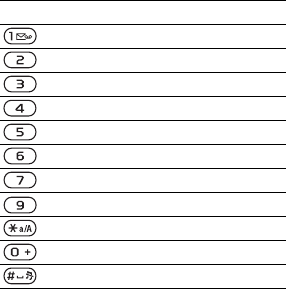
47Connectivity
To start browsing
•From standby select Menu > Internet.
To exit the browser
•When you browse the Internet, select
More > Exit Browser.
To view options
•When you browse the Internet, select
More.
When you browse the Internet
You can make a call or send a link
when you browse the Internet.
To make a call
•When you browse the Internet, select
More >Tools > Make a Call.
To send a link
1When you browse the Internet, select
More > Tools > Send Link.
2Select an option.
Using bookmarks
You can create and edit bookmarks as
quick links to your favorite Web pages.
To create a bookmark
1From standby select Menu > Internet
>More > Go to > Bookmarks.
2Scroll to New Bookmark and select
Add.
3Enter the information and select Save.
To select a bookmark
1From standby select Menu > Internet
>More > Go to > Bookmarks.
2Scroll to a bookmark and select Go To.
Internet keypad shortcuts
You can use the keypad to go directly
to an Internet browser function.
To select Internet keypad shortcuts
•From standby select Menu > Internet
>More > Options >the Browsing tab
>Keypad Mode > Shortcuts.
Key Shortcut
Bookmarks
Enter Address
Search Internet
History
Refresh Page
Forward
Page up
Page down
Full Screen or Normal Screen.
Zoom
Shortcuts
This is the Internet version of the User's guide. © Print only for private use.
48 Connectivity
Downloading
You can download files, for example,
pictures, themes, games and ringtones
from Web pages.
To download from a Web page
1When you browse the Internet, select
a file to download.
2Follow the instructions on the screen.
Internet profiles
You can select another Internet profile
if you have more than one.
To select an Internet profile for the
Internet browser
1From standby select Menu > Settings
>the Connectivity tab > Internet
Settings > Internet Profiles.
2Select an option.
Internet security and certificates
Your phone supports secure
browsing. Certain Internet services,
such as banking, require certificates in
your phone. Your phone may already
contain certificates when you buy it
or you can download new certificates.
To view certificates in the phone
•From standby select Menu > Settings
>the General tab > Security
>Certificates.
RSS Reader
You can receive frequently
updated content, such as news
headlines, as feeds, using Really
Simple Syndication (RSS).
To add new feeds for a Web page
•When you browse the Internet, select
More > RSS Feeds.
To create a new feed
1From standby select Menu > Messaging
>RSS Reader > More > New Feed.
2Enter the address and select Go To.
To set and use RSS reader options
1From standby select Menu > Messaging
>RSS Reader > More.
2Select an option.
Bluetooth™ Wireless
Technology
The Bluetooth function makes wireless
connection to other Bluetooth devices
possible. You can, for example:
•Connect to handsfree devices.
•Connect to stereo headsets.
•Connect to more than one device
at the same time.
•Connect to computers and access
the Internet.
This is the Internet version of the User's guide. © Print only for private use.

49Connectivity
•Synchronize information with
computers.
•Use media viewer accessories.
•Exchange items and play multiplayer
games.
Before you use Bluetooth wireless
technology
You must turn on the Bluetooth
function to communicate with other
devices. You must also pair your
phone with other Bluetooth devices.
To turn the Bluetooth function on
•From standby select Menu > Settings
>the Connectivity tab > Bluetooth
>Turn On.
To pair the phone with a device
1From standby select Menu > Settings
>the Connectivity tab > Bluetooth
>My Devices > New Device to search
for available devices.
2Select a device.
3Enter a passcode, if required.
To allow connection to the phone
1From standby select Menu > Settings
>the Connectivity tab > Bluetooth
>My Devices.
2Select a device from the list.
3Select More > Allow Connection.
To pair the phone with a Bluetooth
handsfree for the first time
1From standby select Menu > Settings
>the Connectivity tab > Bluetooth
>Handsfree.
2Select Yes.
3Enter a passcode, if required.
To pair the phone with more than one
Bluetooth handsfree
1From standby select Menu > Settings
>the Connectivity tab > Bluetooth
>Handsfree > My Handsfree > New
Handsfree.
2Scroll to a device and select Add.
Power save
You can save battery power with this
function. You can only connect with a
single Bluetooth device. You must turn
this function off if you want to connect
with more than one Bluetooth device
at the same time.
To turn powersave on
•From standby select Menu > Settings
>the Connectivity tab > Bluetooth
>Powersave > On.
We recommend a range within 33 feet
(10 meters), with no solid objects in
between, for Bluetooth communication.
Make sure that the device you want to
pair your phone with has the Bluetooth
function activated and is made visible.
This is the Internet version of the User's guide. © Print only for private use.
50 Connectivity
Phone name
You can enter a name for your phone
to be shown when other devices find it.
To enter a phone name
1From standby select Menu > Settings
>the Connectivity tab > Bluetooth
>Phone Name.
2Enter the phone name and select OK.
Visibility
If you want other Bluetooth devices to
be able to discover your phone, you can
choose to make your phone visible.
To show your phone
•From standby select Menu > Settings
>the Connectivity tab > Bluetooth
>Visibility > Show Phone.
Exchanging items
Send or receive items using Bluetooth
wireless technology as the transfer
method. Choose a device from the list
of found devices.
To send a contact
1From standby select Menu > Contacts.
2Scroll to a contact and select More
>Send Contact > Via Bluetooth.
3Select the device to send the item to.
To receive an item
1From standby select Menu > Settings
>the Connectivity tab > Bluetooth
>Turn On.
2Select Visibility > Show Phone.
3When you receive an item, follow the
instructions on the screen.
Transferring sound to and from
a Bluetooth handsfree
You can transfer the sound to and from a
Bluetooth handsfree. To do this, you can
use a phone key or the handsfree key.
To transfer sound
1From standby select Menu > Settings
>the Connectivity tab > Bluetooth
>Handsfree > Incoming Call.
2Select an option. In Phone transfers
sound to the phone. In Handsfree
transfers sound to the handsfree.
File transfer
You can synchronize and transfer files
using Bluetooth wireless technology.
See Synchronization using a computer
on page 52.
Using the USB Cable
You can connect your phone to
a computer with the USB cable to
transfer files using File Transfer.
You can also synchronize, transfer files
This is the Internet version of the User's guide. © Print only for private use.
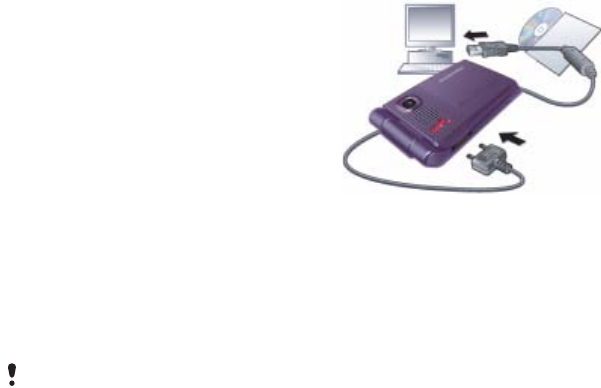
51Connectivity
and use your phone as a modem using
Phone Mode. For more information
go to the Getting started section at
www.sonyericsson.com/support.
Before you use the USB cable
You need one of the these operating
systems to transfer files using a USB
cable:
•Windows 2000
•Windows XP (Pro and Home)
•Windows Vista™ (32 bit and 64 bit
versions of: Ultimate, Enterprise,
Business, Home Premium, Home
Basic)
File transfer
You can drag and drop files between
your phone or memory card and
acomputer in Microsoft Windows
Explorer.
To use file transfer mode
1Connect the USB cable to the phone
and the computer.
2
Phone:
Select
File Transfer
. The phone
will shut down in this mode and restart
when disconnected from the USB cable.
3
Computer:
Wait until the phone memory
and memory card appear as external
disks in
Windows Explorer
.
4Drag and drop selected files between
the phone and the computer.
To disconnect the USB cable safely
1Right-click the removable disk icon in
Windows Explorer.
2Select Eject.
3Disconnect the USB cable.
Only use a USB cable supported by your
phone. Do not remove the USB cable
from your phone or computer during file
transfer as this may corrupt the phone
memory or the memory card.
This is the Internet version of the User's guide. © Print only for private use.

52 Connectivity
Phone mode
Before synchronizing or using your
phone as a modem you must install
the Sony Ericsson PC Suite software
on your computer. See To install the
Sony Ericsson PC Suite on page 52.
To use phone mode
1Computer: Start PC Suite from Start/
Programs/Sony Ericsson/PC Suite.
2Connect the USB cable to the phone
and the computer.
3Phone: Select Phone Mode.
4Computer: When you are notified that
the Sony Ericsson PC Suite has found
your phone, you can start using the
phone mode applications.
Synchronizing
You can use the USB cable or
Bluetooth wireless technology
to synchronize phone contacts,
appointments, tasks and notes with a
computer program such as Microsoft
Outlook®. For more information go
to the Getting started section at
www.sonyericsson.com/support.
Synchronization using a computer
Before synchronizing you need to
install the Sony Ericsson PC Suite
from the CD included with your
phone. The software includes help
information. You can also go to
www.sonyericsson.com/support to
download the software.
You need one of these operating
systems to use the PC Suite on
your computer:
•Windows XP (Pro and Home) with
SP1/SP2
•Windows Vista (32 bit and 64 bit
versions of: Ultimate, Enterprise,
Business, Home Premium, Home
Basic)
To install the Sony Ericsson PC Suite
1Turn on your computer and insert the
CD that came with the phone. The CD
starts automatically and the installation
window opens.
2Select a language and click OK.
3Click Install Sony Ericsson PC Suite
and follow the instructions on the
screen.
For usage details, see the Sony Ericsson
PC Suite Help section once the software
has been installed on your computer.
Use only one of the synchronization
methods at a time with your phone.
This is the Internet version of the User's guide. © Print only for private use.

53Connectivity
Synchronization using an Internet
service
You can synchronize online using an
Internet service with your phone. If
Internet settings are not in your phone,
see Settings on page 46.
Before you start to synchronize
You must enter settings for remote
synchronization and register a
synchronization account online with
a service provider. Settings that are
required are:
•Server Address – server URL.
•Username – account username.
•Password – account password.
•Connection – select an Internet
profile.
•Applications – mark applications
to synchronize.
•App. Settings – select an application
and enter a database name, and if
required, username and password.
•Sync. Interval – set how often to
synchronize.
•Remote Initiation – select an option to
use when you start synchronization
from a service.
•Remote Security – enter a server ID
and a server password.
To enter settings for remote
synchronization
1From standby select Menu > Organizer
>Synchronization.
2Scroll to New Account and select Add.
3Enter a name for the new account and
select Continue.
4Enter the settings and select Save.
To delete an account
1From standby select Menu > Organizer
>Synchronization.
2Scroll to an account and select More
>Delete.
To start remote synchronization
1From standby select Menu > Organizer
>Synchronization.
2Scroll to an account and select Start.
Update Service
You can update your phone with
the latest software. You do not lose
personal or phone information.
There are two ways to update your
phone:
•Over the air using your phone
•Using the provided USB cable and
an Internet-connected computer
The update service requires data
access (GPRS).
This is the Internet version of the User's guide. © Print only for private use.
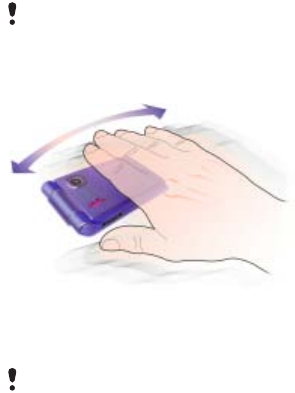
54 More Features
Before you use the Update service
If settings are not in your phone,
see Settings on page 46.
To view the current software in the
phone
1From standby select Menu > Settings
>the General tab > Update Service.
2Select Software Version.
To use Update service using the phone
1From standby select Menu > Settings
>the General tab > Update Service.
2Select Search For Update and follow
the instructions on the screen.
To use Update service using
aUSBcable
1Go to www.sonyericsson.com/support
or click the Sony Ericsson Update
service in the PC Suite software if
installed on your computer. See To
install the Sony Ericsson PC Suite on
page 52.
2Select a region and country.
3Follow the instructions on the screen.
To set a reminder to use Update
service
1From standby select Menu > Settings
>the General tab > Update Service
>Reminder.
2Select an option.
More Features
Gesture Control
With gesture control you can silence
incoming calls or snooze the alarm
without touching the phone.
To silence incoming calls
•When the phone rings, sweep your
hand back and forth once in front of
the camera lens.
Wait for the gesture control light to flash
before you sweep your hand back and
forth.
The distance between your hand and the
camera lens must be 0-3 inches (0-7 cm).
This is the Internet version of the User's guide. © Print only for private use.

55More Features
To snooze the alarm
•When the alarm sounds, sweep your
hand back and forth once in front of
the camera lens.
To turn gesture control on
•From standby select Menu > Settings
>the General tab > Gesture control
>On.
Alarms
You can set a sound or the radio as an
alarm signal. The alarm sounds even if
the phone is set to silent or turned off.
When the alarm sounds you can
silence it for 9 minutes or turn it off.
To set the alarm
1From standby select Menu > Organizer
>Alarms.
2Scroll to an alarm and select Edit.
3Scroll to Time: and select Edit.
4Enter a time and select OK > Save.
To set the recurring alarm
1From standby select Menu > Organizer
>Alarms.
2Scroll to an alarm and select Edit.
3Scroll to Recurrent: and select Edit.
4Scroll to a day and select Mark.
5Select Done > Save.
To set the alarm signal
1From standby select Menu > Organizer
>Alarms.
2Scroll to an alarm and select Edit.
3Scroll to Alarm Signal: and select Edit.
4Scroll to an option and select Save.
To silence the alarm
•When the alarm sounds, press any key.
To silence the radio alarm
•When the alarm sounds, select Snooze.
To turn off an alarm
•When the alarm sounds, select Turn Off.
To cancel the alarm
1From standby select Menu > Organizer
>Alarms.
2Scroll to an alarm and select Turn Off.
Calendar
The calendar can be synchronized with
a computer calendar or with a calendar
on the Web. See Synchronizing on
page 52.
Appointments
You can add new appointments
or reuse existing appointments.
The distance between your hand and the
camera lens must be 0-3 inches (0-7 cm).
This is the Internet version of the User's guide. © Print only for private use.

56 More Features
To add an appointment
1From standby select Menu > Organizer
>Calendar.
2Select a date.
3Scroll to New Appointmnt and select
Add.
4Enter the information and confirm each
entry.
5Select Save.
To view an appointment
1From standby select Menu > Organizer
>Calendar.
2Select a date.
3Scroll to an appointment and select
View.
To reuse an existing appointment
1From standby select Menu > Organizer
>Calendar.
2Select a date.
3Scroll to an appointment and select
View.
4Select More > Edit.
5Edit the appointment and confirm each
entry.
6Select Save.
To send an appointment
1From standby select Menu > Organizer
>Calendar.
2Select a date.
3Scroll to an appointment and select
More > Send.
4Select a transfer method.
To view a calendar week
1From standby select Menu > Organizer
>Calendar.
2Select a date.
3Select More > View Week.
To set when reminders should sound
1From standby select Menu > Organizer
>Calendar.
2Select a date.
3Select More > Advanced > Reminders.
4Select an option.
Navigating your calendar
You can use the navigation key to
move between days or weeks. In the
monthly view, you can use keypad
shortcuts.
Make sure the receiving device supports
the transfer method you select.
A reminders option set in calendar
affects a reminders option set in tasks.
This is the Internet version of the User's guide. © Print only for private use.
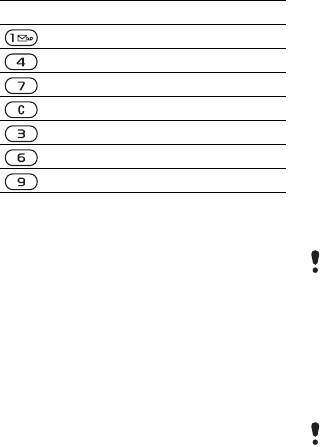
57More Features
Calendar settings
To view calendar options
1From standby select Menu > Organizer
>Calendar.
2Select More.
Tasks
You can add new tasks or reuse
existing tasks.
To add a task
1From standby select Menu > Organizer
>Tasks.
2Select New Task > Add.
3Select an option.
4Enter details and confirm each entry.
To view a task
1From standby select Menu > Organizer
>Tasks.
2Scroll to a task and select View.
To reuse an existing task
1From standby select Menu > Organizer
>Tasks.
2Scroll to a task and select View.
3Select More > Edit.
4Edit the task and select Continue.
5Choose to set a reminder.
To send a task
1From standby select Menu > Organizer
>Tasks.
2Scroll to a task and select More > Send.
3Select a transfer method.
To set when reminders should sound
1From standby select Menu > Organizer
>Tasks.
2Scroll to a task and select More
>Reminders.
3Select an option.
Notes
You can make notes and save them.
You can also show a note in standby.
Key Shortcut
Back a week
Back a month
Back a year
Today’s date
Next week
Next month
Next year
Make sure the receiving device supports
the transfer method you select.
A reminders option set in tasks affects
a reminders option set in calendar.
This is the Internet version of the User's guide. © Print only for private use.

58 More Features
To add a note
1From standby select Menu > Organizer
>Notes.
2Select New Note > Add.
3Write a note and select Save.
To show a note in standby
1From standby select Menu > Organizer
>Notes.
2Scroll to a note and select More
>Show in Standby.
To edit a note
1From standby select Menu > Organizer
>Notes.
2Scroll to a note and select More > Edit.
3Edit the note and select Save.
To send a note
1From standby select Menu > Organizer
>Notes.
2Scroll to a note and select More > Send.
3Select a transfer method.
Timer, Stopwatch and
Calculator
To use the timer
1From standby select Menu > Organizer
>Timer.
2Enter the hours, minutes and seconds.
3Select Start.
To use the stopwatch
1From standby select Menu > Organizer
>Stopwatch > Start.
2To view a new lap time, select New Lap.
To use the calculator
1From standby select Menu > Organizer
>Calculator.
2Press or to select ÷ x - + . % =.
Code Memo
You can save security codes, for
example, for credit cards. You must set
a passcode to open the code memo.
Checkword
The checkword confirms that you
have entered the correct passcode.
If the passcode is correct, the correct
codes are shown. If the passcode
is incorrect, the checkword and the
codes shown are also incorrect.
To open code memo for the first time
1From standby select Menu > Organizer
>Code Memo.
2Follow the instructions on the screen
and select Continue.
3Enter a passcode and select Continue.
4Confirm the passcode and select
Continue.
5Enter a checkword and select Done.
Make sure the receiving device supports
the transfer method you select.
This is the Internet version of the User's guide. © Print only for private use.
59More Features
To add a code
1From standby select Menu > Organizer
>Code Memo.
2Enter a passcode and select New Code
>Add.
3Enter a name associated with the code
and select Continue.
4Enter the code and select Done.
To change a passcode
1From standby select Menu > Organizer
>Code Memo.
2Enter your passcode and select More
>Change Passcode.
3Enter your new passcode and select
Continue.
4Re-enter the new passcode and select
Continue.
5Enter a checkword and select Done.
Forget your passcode?
If you forget your passcode, you
must reset the code memo. This
means that all entries in the code
memo are deleted. The next time
you enter the code memo, you must
proceed as if you are opening it for
the first time. See To open code
memo for the first time on page 58.
To reset code memo
1From standby select Menu > Organizer
>Code Memo.
2Enter any passcode to access the code
memo. The checkword and codes that
are then shown are incorrect.
3Select More > Reset.
4Reset code memo? appears.
5Select Yes.
Profiles
Profiles automatically adapt your
phone to different situations, for
example, while in a meeting or when
driving. Some profiles settings, for
example, ring volume may be adjusted
automatically to suit a certain area or
accessory. You can reset all profile
settings to how they were set when
you bought your phone.
To select a profile
1From standby select Menu > Settings
>the General tab > Profiles.
2Select a profile.
To view and edit a profile
1From standby select Menu > Settings
>the General tab > Profiles.
2Scroll to a profile and select More
>View And Edit.
This is the Internet version of the User's guide. © Print only for private use.

60 More Features
To reset all profiles
1From standby select Menu > Settings
>the General tab > Profiles.
2Scroll to a profile and select More
>Reset Profiles.
Time and Date
To set the time
1From standby select Menu > Settings
>the General tab > Time & Date
>Time.
2Enter the time and select Save.
To set the date
1From standby select Menu > Settings
>the General tab > Time & Date
>Date.
2Enter the date and select Save.
Themes
You can change the appearance of
the screen through items such as
colors and wallpaper. You can also
create new themes and download
them. For more information, go to
www.sonyericsson.com/support.
To set a theme
1From standby select Menu > File
Manager > Themes.
2Scroll to a theme and select Set.
Locks
SIM card lock
This lock only protects your subscription.
Your phone will work with a new SIM
card. If the lock is on, you have to enter
a PIN (Personal Identity Number).
If you enter your PIN incorrectly
three times in a row, the SIM card
is blocked and you need to enter
your PUK (Personal Unblocking Key).
Your PIN and PUK are supplied by
your network operator.
To unblock the SIM card
1When PIN Blocked appears, enter your
PUK and select OK.
2Enter a new four-to-eight-digit PIN and
select OK.
3Re-enter the new PIN and select OK.
You cannot rename the Normal profile.
This is the Internet version of the User's guide. © Print only for private use.

61More Features
To edit the PIN
1From standby select Menu > Settings
>the General tab > Security > Locks
>SIM Protection > Change PIN.
2Enter your PIN and select OK.
3Enter a new four-to-eight-digit PIN
and select OK.
4Re-enter the new PIN and select OK.
To use the SIM card lock
1From standby select Menu > Settings
>the General tab > Security > Locks
>SIM Protection > Protection.
2Select an option.
3Enter your PIN and select OK.
Phone lock
You can stop unauthorized use of
your phone. Change the phone lock
code (0000) to any four-to-eight-digit
personal code.
To use the phone lock
1From standby select Menu > Settings
>the General tab > Security > Locks
>Phone Protection > Protection.
2Select an option.
3Enter the phone lock code and
select OK.
To change the phone lock code
1From standby select Menu > Settings
>the General tab > Security > Locks
>Phone Protection > Change Code.
2Enter the old code and select OK.
3Enter the new code and select OK.
4Repeat the code and select OK.
Music key lock
When the phone is closed you can use
the music key lock to lock and unlock
the music keys.
To lock and unlock the music keys
•Slide the music key lock switch.
IMEI Number
Keep a copy of your IMEI (International
Mobile Equipment Identity) number in
case your phone should be stolen.
To view your IMEI number
•From standby press , , ,
, .
If Codes do not match. appears,
you entered the new PIN incorrectly.
If Wrong PIN. appears, followed by
Old PIN:, you entered your old PIN
incorrectly.
It is important that you remember
your new code. If you forget it, you
have to take your phone to your local
Sony Ericsson retailer.
This is the Internet version of the User's guide. © Print only for private use.
62 Troubleshooting
Troubleshooting
Why doesn’t the phone work the way
I want it to?
Some problems will require you to call
your network operator.
For more support go to
www.sonyericsson.com/support.
Common Questions
I have problems with memory capacity
or the phone is working slowly
Restart your phone every day to free
memory or do a Master Reset.
Master reset
If you select
Reset Settings
, the changes
that you have made to settings will be
deleted.
If you select Reset All, in addition to
your changes to settings, all contacts,
messages, personal data, and content
that you have downloaded, received
or edited will also be deleted.
To reset the phone
1From standby select Menu > Settings
>the General tab > Master Reset
>Reset Settings.
2Follow the instructions on the screen
and select Continue.
I cannot charge the phone or battery
capacity is low
The charger is not properly connected or
the battery connection is poor. Remove
the battery and clean the connectors.
The battery is worn out and needs to
be replaced. See Charging the Battery
on page 8.
No battery icon appears when I start
charging the phone
It may take a few minutes before the
battery icon appears on the screen.
Some menu options appear in gray
A service is not activated. Contact your
network operator.
I cannot use SMS/text messages
on my phone
Settings are missing or incorrect.
Contact your network operator to find
out the correct SMS service center
setting. See
Text Messages
on page 27.
I cannot use picture messages on my
phone
Your subscription does not include
data capability. Settings are missing
or incorrect. Please contact your
network operator.
This is the Internet version of the User's guide. © Print only for private use.

63Troubleshooting
See
Help in your Phone
on page 7 or go
to
www.sonyericsson.com/support
to
order settings and follow the instructions
on the screen. See
Settings
on page 46.
How do I turn on and off T9 text input
when writing a text message?
When you enter text, press and hold
down You will see “T9” at the
top of the text message when T9 is
activated.
How do I change phone language?
1From standby select Menu > Settings
>the General tab > Language > Phone
Language.
2Select an option.
I cannot use the Internet
Your subscription does not include
data capability. Internet settings are
missing or incorrect. Please contact
your network operator.
See Help in your Phone on page 7 or
go to www.sonyericsson.com/support
to order Internet settings and follow
the instructions on the screen. See
Settings on page 46.
The phone cannot be detected
by other devices using Bluetooth
wireless technology
You have not turned the Bluetooth
function on.
Make sure that the visibility is set to
show phone. See To receive an item
on page 50.
I cannot synchronize or transfer data
between my phone and my computer,
when using the USB cable.
The cable or software that came
with your phone has not been
properly installed. Go to
www.sonyericsson.com/support,
to read Getting started guides which
contain detailed installation instructions
and troubleshooting guides.
Error Messages
Insert SIM.
There is no SIM card in your phone or
you may have inserted it incorrectly.
See Charging the Battery on page 8.
This is the Internet version of the User's guide. © Print only for private use.
64 Troubleshooting
The SIM card connectors need
cleaning. If the card is damaged,
contact your network operator.
Insert correct SIM card.
Your phone is set to work only with
certain SIM cards. Check if you are
using the correct operator SIM card.
Wrong PIN./Wrong PIN2.
You have entered your PIN or PIN2
incorrectly.
Enter the correct PIN or PIN2 and
select Yes. See To insert the SIM card
on page 5.
PIN Blocked/PIN2 blocked.
You have entered your PIN or PIN2
code incorrectly three times in a row.
To unblock, see SIM card lock on
page 60.
Codes do not match.
Codes that you have entered do not
match. When you want to change a
security code, for example your PIN,
you have to confirm the new code.
See SIM card lock on page 60.
No Nwk Coverage
Your phone is in flight mode. See
Flight mode on page 7.
Your phone is not receiving any radio
signal, or the received signal is too
weak. Contact your network operator
and make sure that the network has
coverage where you are.
The SIM card is not working properly.
Insert your SIM card in another phone.
If this works, it is probably your phone
that is causing the problem. Please
contact the nearest Sony Ericsson
service location.
Emerg. Calls Only
You are within range of a network,
but you are not allowed to use it.
However, in an emergency, some
network operators allow you to call the
international emergency number 112.
See Emergency Calls on page 19.
PUK blocked. Contact provider.
You entered your personal unblocking
key code (PUK) incorrectly 10 times in
a row.
Charging - Non-standard battery.
The battery that you are using is not
aSonyEricsson-approved battery.
See Battery on page 68.
This is the Internet version of the User's guide. © Print only for private use.
65Important Information
Important Information
Sony Ericsson Consumer Web site
On www.sonyericsson.com/support is a support
section where help and tips are only a few clicks
away. Here you will find the latest computer
software updates and tips on how to use your
product more efficiently.
Service and support
From now on you will have access to a portfolio
of exclusive service advantages such as:
• Global and local Web sites providing support.
• A global network of Call Centers.
• An extensive network of Sony Ericsson service
partners.
• A warranty period. Learn more about the warranty
conditions in this User guide.
On www.sonyericsson.com, under the support
section in the language of your choice, you will find
the latest support tools and information, such as
software updates, Knowledge base, phone setup
and additional help when you require it.
For operator-specific services and features, please
contact your network operator for more information.
You can also contact our Call Centers. See the phone
number for the nearest Call Center in the list below.
If your country/region is not represented in the list,
please contact your local dealer. (The phone numbers
below were correct at the time of going to print. On
www.sonyericsson.com you can always find the
latest updates).
In the unlikely event that your product needs
service please contact the dealer from whom it was
purchased or one of our service partners. Save your
original proof of purchase, you will need it if you need
to claim warranty.
For a call to one of our Call Centers you will be
charged according to national rates, including local
taxes, unless the phone number is a toll-free number.
Support
Argentina 800-333-7427 questions.AR@support.sonyericsson.com
Australia 1-300650-600 questions.AU@support.sonyericsson.com
Belgique/België 02-7451611 questions.BE@support.sonyericsson.com
Brasil 4001-04444 questions.BR@support.sonyericsson.com
Canada 1-866-766-9374 questions.CA@support.sonyericsson.com
Central Africa +27 112589023 questions.CF@support.sonyericsson.com
Chile 123-0020-0656 questions.CL@support.sonyericsson.com
Colombia 18009122135 questions.CO@support.sonyericsson.com
Česká republika 844550 055 questions.CZ@support.sonyericsson.com
Danmark 33 31 28 28 questions.DK@support.sonyericsson.com
Deutschland 0180 534 2020 questions.DE@support.sonyericsson.com
Ελλάδα 801-11-810-810
210-89 91 919 questions.GR@support.sonyericsson.com
España 902 180 576 questions.ES@support.sonyericsson.com
France 0 825 383 383 questions.FR@support.sonyericsson.com
This is the Internet version of the User's guide. © Print only for private use.

66 Important Information
Hong Kong/ 8203 8863 questions.HK@support.sonyericsson.com
Hrvatska 062 000 000 questions.HR@support.sonyericsson.com
India/ 39011111 questions.IN@support.sonyericsson.com
Indonesia 021-2701388 questions.ID@support.sonyericsson.com
Ireland 1850 545 888 questions.IE@support.sonyericsson.com
Italia 06 48895206 questions.IT@support.sonyericsson.com
Lietuva 8 70055030 questions.LT@support.sonyericsson.com
Magyarország +36 1 880 4747 questions.HU@support.sonyericsson.com
Malaysia 1-800-889900 questions.MY@support.sonyericsson.com
México 01 800 000 4722 questions.MX@support.sonyericsson.com
Nederland 0900 899 8318 questions.NL@support.sonyericsson.com
New Zealand 0800-100150 questions.NZ@support.sonyericsson.com
Norge 815 00 840 questions.NO@support.sonyericsson.com
Österreich 0810 200245 questions.AT@support.sonyericsson.com
Pakistan 111 22 55 73
(92-21) 111 22 55 73 questions.PK@support.sonyericsson.com
Philippines/Pilipinas 02-6351860 questions.PH@support.sonyericsson.com
Polska 0 (prefiks) 22 6916200 questions.PL@support.sonyericsson.com
Portugal 808 204 466 questions.PT@support.sonyericsson.com
România (+4021) 401 0401 questions.RO@support.sonyericsson.com
Россия 8 (495) 787 0986 questions.RU@support.sonyericsson.com
Schweiz/Suisse/Svizzera 0848 824 040 questions.CH@support.sonyericsson.com
Singapore 67440733 questions.SG@support.sonyericsson.com
Slovensko 02-5443 6443 questions.SK@support.sonyericsson.com
South Africa 0861 6322222 questions.ZA@support.sonyericsson.com
Suomi 09-299 2000 questions.FI@support.sonyericsson.com
Sverige 013-24 45 00 questions.SE@support.sonyericsson.com
Türkiye 0212 473 77 71 questions.TR@support.sonyericsson.com
Україна (+0380) 44 590 1515 questions.UA@support.sonyericsson.com
United Kingdom 08705 23 7237 questions.GB@support.sonyericsson.com
United States 1-866-7669347 questions.US@support.sonyericsson.com
Venezuela 0-800-100-2250 questions.VE@support.sonyericsson.com
43 919880 questions.AE@support.sonyericsson.com
4008100000 questions.CN@support.sonyericsson.com
02-25625511 questions.TW@support.sonyericsson.com
02-2483030 questions.TH@support.sonyericsson.com
This is the Internet version of the User's guide. © Print only for private use.
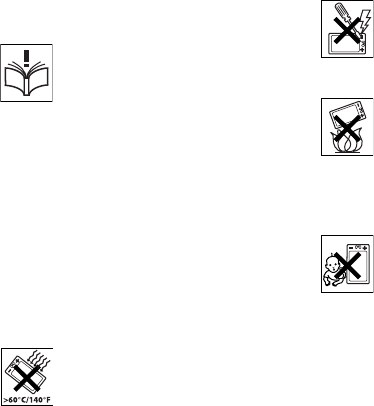
67Important Information
Guidelines for Safe and
Efficient Use
Please read this information before
using your phone.
These instructions are intended
for your safety. Please follow these
guidelines. If the product has been
subject to any of the conditions listed
below or you have any doubt as to its proper
function make sure you have the product checked
by a certified service partner before charging or
using it. Failure to do so might entail a risk of
product malfunction or even a potential hazard to
your health.
Recommendations for safe use of
product (phone, battery, charger and
other accessories)
• Always treat your product with care and keep it in
a clean and dust-free place.
•Warning! May explode if disposed of in fire.
• Do not expose your product to liquid or moisture
or humidity.
• Do not expose your product to
extremely high or low temperatures. Do
not expose the battery to temperatures
above +140oF (+60oC).
• Do not expose your product to open
flames or lit tobacco products.
• Do not drop, throw or try to bend your product.
• Do not paint your product.
• Do not attempt to disassemble or modify your
product. Only Sony Ericsson authorized personnel
should perform service.
• Do not close your product with an object inserted
between keypad and display if you have a clamshell
phone; this may damage your product.
• Do not use your product near medical
equipment without requesting
permission from your treating physician
or authorized medical staff.
• Do not use your product when in,
or around aircraft, or areas showing
the sign “turn off two-way radio”.
• Do not use your product in an
area where a potentially explosive
atmosphere exists.
• Do not place your product or install
wireless equipment in the area above
an air bag in your car.
•Caution: Cracked or broken displays may create
sharp edges or splinters that could be harmful upon
contact.
CHILDREN
KEEP OUT OF CHILDREN´S
REACH. DO NOT ALLOW CHILDREN
TO PLAY WITH YOUR PHONE OR ITS
ACCESSORIES. THEY COULD HURT
THEMSELVES OR OTHERS, OR COULD
ACCIDENTALLY DAMAGE THE PHONE OR
ACCESSORY. YOUR PHONE OR ITS ACCESSORY
MAY CONTAIN SMALL PARTS THAT COULD
BECOME DETACHED AND CREATE A CHOKING
HAZARD.
Power supply (Charger)
Connect the AC power adapter only to designated
power sources as marked on the product. Make
sure the cord is positioned so that it will not be
subjected to damage or stress. To reduce risk of
electric shock, unplug the unit from any power
source before attempting to clean it. The AC power
adapter must not be used outdoors or in damp
areas. Never alter the cord or plug. If the plug does
not fit into the outlet, have a proper outlet installed
by a qualified electrician.
This is the Internet version of the User's guide. © Print only for private use.
68 Important Information
Use only Sony Ericsson branded original chargers
intended for use with your phone. Other chargers
may not be designed to the same safety and
performance standards.
Battery
We recommend that you fully charge the
battery before you use your phone for the first
time. A new battery or one that has not been used
for a long time could have reduced capacity the
first few times it is used. The battery should only
be charged in temperatures between +41°F (+5°C)
and +113°F (+45°C).
Use only Sony Ericsson branded original batteries
intended for use with your phone. Using other
batteries and chargers could be dangerous.
Talk and standby times depend on several different
conditions such as signal strength, operating
temperature, application usage patterns, features
selected and voice or data transmissions when the
phone is being used.
Turn off your phone before removing the battery.
Do not put the battery into your mouth. Battery
electrolytes may be toxic if swallowed. Do not let
the metal contacts on the battery touch another
metal object. Doing this could short-circuit and
damage the battery. Use the battery for the
intended purpose only.
Personal medical devices
Phones may affect the operation of pacemakers
and other implanted equipment. Please avoid placing
the phone over the pacemaker, for example in your
breast pocket. When using the phone, use it at the ear
on the opposite side of the body to the pacemaker.
If a minimum distance of 6 inches (15 cm) is kept
between the phone and the pacemaker, the risk
of interference is limited. If you have any reason to
suspect that interference is taking place, immediately
turn off your phone. Contact your cardiologist for
more information.
For other medical devices, please consult your
physician and the manufacturer of the device.
Driving
Please check if local laws and regulations restrict
the use of phones while driving or require drivers
to use handsfree solutions. We recommend that
you use only Sony Ericsson handsfree solutions
intended for use with your product.
Please note that because of possible interference to
electronic equipment, some vehicle manufacturers
forbid the use of phones in their vehicles unless a
handsfree kit with an external antenna has been
installed.
Always pay full attention to driving and pull off the
road and park before making or answering a call
if driving conditions so require.
GPS/Location based functions
Some products provide GPS/Location based
functions. Location determining functionality
is provided “AS IS” and “WITH ALL FAULTS”.
Sony Ericsson does not make any representation
or warranty as to the accuracy of such location
information.
Use of location-based information by the device
may not be uninterrupted or error free and may
additionally be dependent on network service
availability. Please note that functionality may be
reduced or prevented in certain environments such
as building interiors or areas adjacent to buildings.
Caution: Do not use GPS functionality in a manner
which causes distraction from driving.
Emergency calls
Phones operate using radio signals, which cannot
guarantee connection in all conditions. You should
therefore never rely solely upon any phone for essential
communications (for example medical emergencies).
Emergency calls may not be possible in all areas,
on all cellular networks, or when certain network
services and/or phone features are in use. Check
with your local service provider.
This is the Internet version of the User's guide. © Print only for private use.
69Important Information
Antenna
This phone contains a built-in antenna. Use of
antenna devices not marketed by Sony Ericsson
specifically for this model could damage your
phone, reduce performance, and produce SAR
levels above the established limits (see below).
Efficient use
Hold your phone as you would any other phone.
Do not cover the top of the phone when it is in use,
as this affects call quality and may cause the phone
to operate at a higher power level than needed,
thus shortening talk and standby times.
Radio frequency (RF) exposure and
Specific Absorption Rate (SAR)
Your phone is a low-power radio transmitter and
receiver. When it is turned on, it emits low levels of
radio frequency energy (also known as radio waves
or radio frequency fields).
Governments around the world have adopted
comprehensive international safety guidelines,
developed by scientific organizations, for example
ICNIRP (International Commission on Non-Ionizing
Radiation Protection) and IEEE (The Institute of
Electrical and Electronics Engineers Inc.), through
periodic and thorough evaluation of scientific
studies. These guidelines establish permitted levels
of radio wave exposure for the general population.
The levels include a safety margin designed to
assure the safety of all persons, regardless of age
and health, and to account for any variations in
measurements.
Specific Absorption Rate (SAR) is the unit of
measurement for the amount of radio frequency
energy absorbed by the body when using a phone.
The SAR value is determined at the highest certified
power level in laboratory conditions, but the actual
SAR level of the phone while it is operating can be
well below this value. This is because the phone
is designed to use the minimum power required to
reach the network.
Variations in SAR below the radio frequency
exposure guidelines do not mean that there are
variations in safety. While there may be differences
in SAR levels among phones, all Sony Ericsson
phone models are designed to meet radio frequency
exposure guidelines.
For phones sold in the US, before a phone model is
available for sale to the public, it must be tested and
certified by the Federal Communications Commission
(FCC) that it does not exceed the limit established
by the government-adopted requirement for safe
exposure. The tests are performed in positions and
locations (that is, at the ear and worn on the body) as
required by the FCC for each model. For body-worn
operation, this phone has been tested and meets
FCC RF exposure guidelines when the handset is
positioned a minimum of 15 mm from the body without
any metal parts in the vicinity of the phone or when
used with the original Sony Ericsson accessory
intended for this phone and worn on the body. Use of
other accessories may not ensure compliance with
FCC RF exposure guidelines.
A separate leaflet with SAR information about
this phone model is included with the material
accompanying this phone. This information can
also be found, together with more information
on radio frequency exposure and SAR, on:
www.sonyericsson.com/health.
Accessible Solutions/Special Needs
For phones sold in the US, you can use your
TTY terminal with your Sony Ericsson phone
(with the necessary accessory). For information
on Accessible Solutions for individuals with special
needs call the Sony Ericsson Special Needs Center
on 877 878 1996 (TTY) or 877 207 2056 (voice),
or visit the Sony Ericsson Special Needs Center at
www.sonyericsson-snc.com.
This is the Internet version of the User's guide. © Print only for private use.

70 Important Information
Disposal of old electrical
and electronic equipment
This symbol indicates that all
electrical and electronic equipment
included shall not be treated as
household waste. Instead it shall be
left at the appropriate collection point for recycling
of electrical and electronic equipment. By ensuring
this product is disposed of correctly, you will help
prevent potential negative consequences for the
environment and human health, which could
otherwise be caused by inappropriate waste
handling of this product. The recycling of materials
will help to conserve natural resources. For more
detailed information about recycling this product,
please contact your local city office, your
household waste disposal service or the shop
where you purchased the product.
Disposing of the battery
Please check local regulations for
disposal of batteries or call your
local Sony Ericsson Call Center for
information.
The battery should never be placed in
municipal waste. Use a battery disposal facility
if available.
Memory card
If your product comes complete with a removable
memory card. It is generally compatible with the
handset purchased but may not be compatible with
other devices or the capabilities of their memory
cards. Check other devices for compatibility before
purchase or use. If your product is equipped with
a memory card reader, check memory card
compatibility before purchase or use.
The memory card is formatted prior to shipping.
To reformat the memory card, use a compatible
device. Do not use the standard operating system
format when formatting the memory card on a PC.
For details, refer to the operating instructions of the
device or contact customer support.
WARNING:
If your device requires an adapter for insertion
into the handset or another device, do not insert
the card directly without the required adapter.
Precautions on Memory Card Use
• Do not expose the memory card to moisture.
• Do not touch terminal connections with your hand
or any metal object.
• Do not strike, bend, or drop the memory card.
• Do not attempt to disassemble or modify the
memory card.
• Do not use or store the memory card in humid or
corrosive locations or in excessive heat such as
a closed car in summer, in direct sunlight or near
a heater, etc.
• Do not press or bend the end of the memory card
adapter with excessive force.
• Do not let dirt, dust, or foreign objects get into the
insert port of any memory card adapter.
• Check you have inserted the memory card correctly.
• Insert the memory card as far as it will go into any
memory card adapter needed. The memory card
may not operate properly unless fully inserted.
• We recommend that you make a backup copy of
important data. We are not responsible for any loss
or damage to content you store on the memory card.
• Recorded data may be damaged or lost when you
remove the memory card or memory card adapter,
turn off the power while formatting, reading or
writing data, or use the memory card in locations
subject to static electricity or high electrical field
emissions.
Protection of personal information
To safeguard your privacy and prevent information
being accessible to a third party, you should erase
all personal data before selling or disposing of the
product. To delete personal data, perform a master
reset, remove the memory card or format the media
memory. DELETION OF MATERIAL FROM THE
This is the Internet version of the User's guide. © Print only for private use.
71Important Information
PHONE AND MEDIA MEMORIES DOES NOT
ENSURE THAT SAID INFORMATION CANNOT
BE RECOVERED BY A SUBSEQUENT USER.
SONY ERICSSON DOES NOT WARRANT
AGAINST A SUBSEQUENT USER OF THE DEVICE
ACCESSING YOUR INFORMATION AND DOES NOT
ASSUME ANY RESPONSIBILITY FOR SUBSEQUENT
DISCLOSURE OF SAID INFORMATION EVEN IF A
MASTER RESET AND A MEDIA MEMORY FORMAT
HAS BEEN PERFORMED. If you are concerned about
such potential disclosure retain your device or secure
its permanent destruction.
Accessories
Sony Ericsson recommends use of Sony Ericsson
original accessories for safe and efficient use of
its products. Use of third-party accessories may
decrease performance or pose a risk to your health
or safety.
LOUDNESS WARNING:
Please adjust the audio volume cautiously when using
third-party audio accessories to avoid volume levels
that may be harmful to your hearing. Sony Ericsson
does not test use of third-party audio accessories
with this phone. Sony Ericsson recommends using
only Sony Ericsson original audio accessories.
End User License Agreement
This wireless device, including without limitation
any media delivered with the device, (“Device”)
contains software owned by Sony Ericsson Mobile
Communications AB and its affiliated companies
(“Sony Ericsson”) and its third party suppliers and
licensors (“Software”).
As user of this Device, Sony Ericsson grants you
a non-exclusive, non-transferable, non-assignable
license to use the Software solely in conjunction
with the Device on which it is installed and/or
delivered with. Nothing herein shall be construed
as a sale of the Software to a user of this Device.
You shall not reproduce, modify, distribute, reverse
engineer, decompile, otherwise alter or use any
other means to discover the source code of the
Software or any component of the Software. For
avoidance of doubt, you are at all times entitled to
transfer all rights and obligations to the Software to
a third party, solely together with the Device with
which you received the Software, provided always
that such third party agrees in writing to be bound
by these rules.
You are granted this license for a term of the useful
life of this Device. You can terminate this license by
transferring all your rights to the Device on which you
have received the Software to a third party in writing. If
you fail to comply with any of the terms and conditions
set out in this license, it will terminate with immediate
effect.
Sony Ericsson and its third party suppliers and
licensors are the sole and exclusive owner of
and retain all rights, title and interest in and to the
Software. Sony Ericsson, and, to the extent that
the Software contains material or code of a third
party, such third party, shall be entitled third party
beneficiaries of these terms.
The validity, construction and performance of this
license shall be governed by the laws of Sweden.
The foregoing shall apply to the full extent permitted
by, when applicable, statutory consumer rights.
Limited Warranty
Sony Ericsson Mobile Communications AB,
Nya Vattentornet, SE-221 88 Lund, Sweden,
(Sony Ericsson) or its local affiliated company,
provides this Limited Warranty for your phone,
original accessory delivered with your phone,
and/or your mobile computing product (hereinafter
referred to as “Product”).
Should your Product need warranty service, please
return it to the dealer from whom it was purchased, or
contact your local Sony Ericsson Call Center (national
rates may apply) or visit www.sonyericsson.com to
get further information.
This is the Internet version of the User's guide. © Print only for private use.
72 Important Information
Our warranty
Subject to the conditions of this Limited Warranty,
Sony Ericsson warrants this Product to be free
from defects in design, material and workmanship
at the time of its original purchase by a consumer.
This Limited Warranty will last for a period of one
(1) year as from the original date of purchase of the
Product.
What we will do
If, during the warranty period, this Product fails
to operate under normal use and service, due
to defects in design, materials or workmanship,
Sony Ericsson authorized distributors or service
partners, in the country* where you purchased
the Product, will, at their option, either repair or
replace the Product in accordance with the terms
and conditions stipulated herein.
Sony Ericsson and its service partners reserve the
right to charge a handling fee if a returned Product
is found not to be under warranty according to the
conditions below.
Please note that some of your personal settings,
downloads and other information may be lost
when your Sony Ericsson Product is repaired
or replaced. At present Sony Ericsson may be
prevented by applicable law, other regulation or
technical restrictions from making a backup copy
of certain downloads. Sony Ericsson does not take
any responsibility for any lost information of any
kind and will not reimburse you for any such loss.
You should always make backup copies of all the
information stored on your Sony Ericsson Product
such as downloads, calendar and contacts before
handing in your Sony Ericsson Product for repair
or replacement.
Conditions
1 This Limited Warranty is valid only if the original
proof of purchase for this Product issued by a
Sony Ericsson authorized dealer specifying the date
of purchase and serial number**, is presented with
the Product to be repaired or replaced. Sony Ericsson
reserves the right to refuse warranty service if this
information has been removed or changed after the
original purchase of the Product from the dealer.
2 If Sony Ericsson repairs or replaces the Product,
the repair for the defect concerned, or the replaced
Product shall be warranted for the remaining time
of the original warranty period or for ninety (90)
days from the date of repair, whichever is longer.
Repair or replacement may involve the use of
functionally equivalent reconditioned units.
Replaced parts or components will become the
property of Sony Ericsson.
3 This warranty does not cover any failure of the
Product due to normal tear and wear, or due to
misuse, including but not limited to use in other than
the normal and customary manner, in accordance
with the Sony Ericsson instructions for use and
maintenance of the Product. Nor does this warranty
cover any failure of the Product due to accident,
software or hardware modification or adjustment,
acts of God or damage resulting from liquid.
A rechargeable battery can be charged and
discharged more than a hundred times. However,
it will eventually wear out - this is not a defect and
corresponds to normal wear and tear. When the
talk-time or standby time is noticeably shorter, it
is time to replace your battery. Sony Ericsson
recommends that you use only batteries and
chargers approved by Sony Ericsson.
Minor variations in display brightness and color
may occur between the phones. There may be tiny
bright or dark dots on the display. These are called
defective pixels and occur when individual dots
have malfunctioned and can not be adjusted. Two
defective pixels are deemed acceptable.
This is the Internet version of the User's guide. © Print only for private use.

73Important Information
Minor variations in camera image appearance may
occur between phones. This is nothing uncommon
and is not regarded as a defective camera module.
4 Since the cellular system on which the Product
is to operate is provided by a carrier independent
from Sony Ericsson, Sony Ericsson will not be
responsible for the operation, availability, coverage,
services or range of that system.
5 This warranty does not cover Product failures
caused by installations, modifications, or repair
or opening of the Product performed by a non-
Sony Ericsson authorized person.
6 The warranty does not cover Product failures which
have been caused by use of accessories or other
peripheral devices which are not Sony Ericsson
branded original accessories intended for use with
the Product.
7 Tampering with any of the seals on the Product will
void the warranty.
8 THERE ARE NO EXPRESS WARRANTIES,
WHETHER WRITTEN OR ORAL, OTHER THAN
THIS PRINTED LIMITED WARRANTY. ALL
IMPLIED WARRANTIES, INCLUDING WITHOUT
LIMITATION THE IMPLIED WARRANTIES OF
MERCHANTABILITY OR FITNESS FOR A
PARTICULAR PURPOSE, ARE LIMITED TO
THE DURATION OF THIS LIMITED WARRANTY.
IN NO EVENT SHALL SONY ERICSSON OR ITS
LICENSORS BE LIABLE FOR INCIDENTAL OR
CONSEQUENTIAL DAMAGES OF ANY NATURE
WHATSOEVER, INCLUDING BUT NOT LIMITED
TO LOST PROFITS OR COMMERCIAL LOSS;
TO THE FULL EXTENT THOSE DAMAGES CAN
BE DISCLAIMED BY LAW.
Some countries/states do not allow the exclusion
or limitation of incidental or consequential
damages, or limitation of the duration of implied
warranties, so the preceding limitations or
exclusions may not apply to you.
The warranty provided does not affect the
consumer's statutory rights under applicable
legislation in force, nor the consumer's rights against
the dealer arising from their sales/purchase contract.
* Geographical scope of the warranty
If you have purchased your Product in a country
member of the European Economic Area (EEA) or
in Switzerland or the Republic of Turkey, and such
Product was intended for sale in the EEA or in
Switzerland or in Turkey, you can have your Product
serviced in any EEA country or in Switzerland or in
Turkey, under the warranty conditions prevailing in
the country in which you require servicing, provided
that an identical Product is sold in such country by
an authorized Sony Ericsson distributor. To find out
if your Product is sold in the country you are in,
please call the local Sony Ericsson Call Center.
Please observe that certain services may not be
possible elsewhere than in the country of original
purchase, for example due to the fact that your
Product may have an interior or exterior which
is different from equivalent models sold in other
countries. Please note in addition that it may
sometimes not be possible to repair SIM-locked
Products.
** In some countries/regions additional information
(such as a valid warranty card) may be requested.
FCC Statement
This device complies with Part 15
of the FCC rules. Operation is subject
to the following two conditions:
(1) This device may not cause
harmful interference, and
(2) This device must accept any interference
received, including interference that may cause
undesired operation.
This is the Internet version of the User's guide. © Print only for private use.
74 Index
Index
A
activity menu ........................................ 15
alarms .................................................. 55
answering service ................................ 23
applications .......................................... 45
appointments ....................................... 55
assembly ................................................ 5
automatic redialing .............................. 19
B
battery
charging ......................................... 8
inserting ......................................... 5
use and care ................................ 68
Bluetooth™ wireless technology ......... 48
business cards ..................................... 27
buttons ............................................. 9, 13
C
calculator ............................................. 58
calendar ............................................... 55
call forward .......................................... 23
call list .................................................. 22
call numbers in message ..................... 28
call time ................................................ 26
caller-specific ringtones ....................... 20
calls
accepting ......................................25
answering ..................................7, 19
handling two calls .........................24
international ..................................19
making ......................................7, 19
putting on hold ..............................24
recording .......................................44
re-dialing .......................................19
rejecting ....................................7, 19
camera
overview ........................................36
settings .........................................37
code memo ...........................................58
conference calls ....................................25
contacts
adding phone contacts .................20
default contacts ............................20
groups of .......................................22
synchronizing ................................52
D
date .......................................................60
downloading files ..................................48
This is the Internet version of the User's guide. © Print only for private use.
75Index
E
email ..................................................... 31
emergency calls ................................... 19
entering text
multitap ........................................ 18
T9™ Text Input ............................ 18
error messages .................................... 63
F
file manager .......................................... 15
fixed dialing .......................................... 26
flight mode ............................................. 7
G
games ................................................... 45
gesture control ..................................... 54
groups .................................................. 22
H
handsfree ............................................. 39
Bluetooth™ technology ............... 49
help ........................................................ 7
I
IMEI number ......................................... 61
Internet
bookmarks ................................... 47
profiles ......................................... 48
security and certificates ............... 48
settings ......................................... 46
J
Java™ .................................................. 45
K
keys .................................................. 9, 13
L
lock
music key ..................................... 61
phone ........................................... 61
SIM card ....................................... 60
M
master reset ......................................... 62
Media Manager .................................... 41
memory card ........................................ 15
memory status ..................................... 22
menu overview ..................................... 11
menus .................................................. 13
message templates .............................. 30
messages ............................................. 27
area and cell information .............. 35
email ............................................. 31
picture message ........................... 29
templates ..................................... 30
text message ................................ 27
voice ............................................. 31
microphone .......................................... 19
music
transferring ................................... 41
This is the Internet version of the User's guide. © Print only for private use.
76 Index
music key lock ..................................... 61
music keys ........................................... 39
music player ......................................... 39
MusicDJ™ ............................................ 44
My friends ............................................ 34
my numbers ......................................... 25
N
navigating menus ................................. 13
notes .................................................... 57
P
PC Suite ............................................... 52
phone
language ...................................... 18
lock .............................................. 61
phone overview ...................................... 9
picture message .................................. 29
pictures ................................................ 38
PIN code
changing ...................................... 61
playlists ................................................ 40
PlayNow™ ........................................... 43
profiles ................................................. 59
PUK ...................................................... 60
push email ............................................ 33
R
radio ......................................................42
restricted calls .......................................26
ringtones ...............................................43
RSS reader ............................................48
S
safety guidelines ...................................67
sending
business cards ..............................27
melodies and ringtones ................44
music ............................................41
pictures .........................................38
settings
Internet ..........................................46
Java™ ...........................................46
shortcuts ...............................................15
SIM card
copying from .................................21
copying to .....................................21
inserting ..........................................5
lock and unblock ..........................60
sound recorder .....................................44
speed dialing .........................................23
standby ...................................................7
startup screen .........................................7
stopwatch .............................................58
submenus .............................................13
synchronizing ........................................52
This is the Internet version of the User's guide. © Print only for private use.
77Index
T
tasks ..................................................... 57
text ....................................................... 18
text message ........................................ 27
themes ................................................. 60
time ...................................................... 60
timer ..................................................... 58
TrackID™ ............................................. 42
transfer method
Bluetooth™ technology ............... 48
USB .............................................. 50
transferring
files ............................................... 50
music ............................................ 41
transferring pictures ............................. 37
troubleshooting .................................... 62
turn on the phone ................................... 6
turning on/off
phone lock ................................... 61
SIM lock protection ...................... 61
U
unblock SIM card ................................. 60
update service ...................................... 53
V
vibrating alert ....................................... 43
video player .......................................... 45
voice messages ................................... 31
voicemail .............................................. 23
volume
ear speaker .................................. 19
ringtone ........................................ 43
W
Walkman® player ................................. 39
warranty ............................................... 71
Z
zoom .................................................... 36
This is the Internet version of the User's guide. © Print only for private use.